In the tourist city of Hue, there is a place that is not only a simple tourist destination, but also a vibrant space of power, art and spirituality - where every step echoes the voice of the past, every curved tile roof reflects the golden light of a distant dynasty. And that is Hue Imperial City.
If you are wondering: what makes this place the heart of the ancient capital of Hue? Let's explore with MLifeOn below.
History of formation
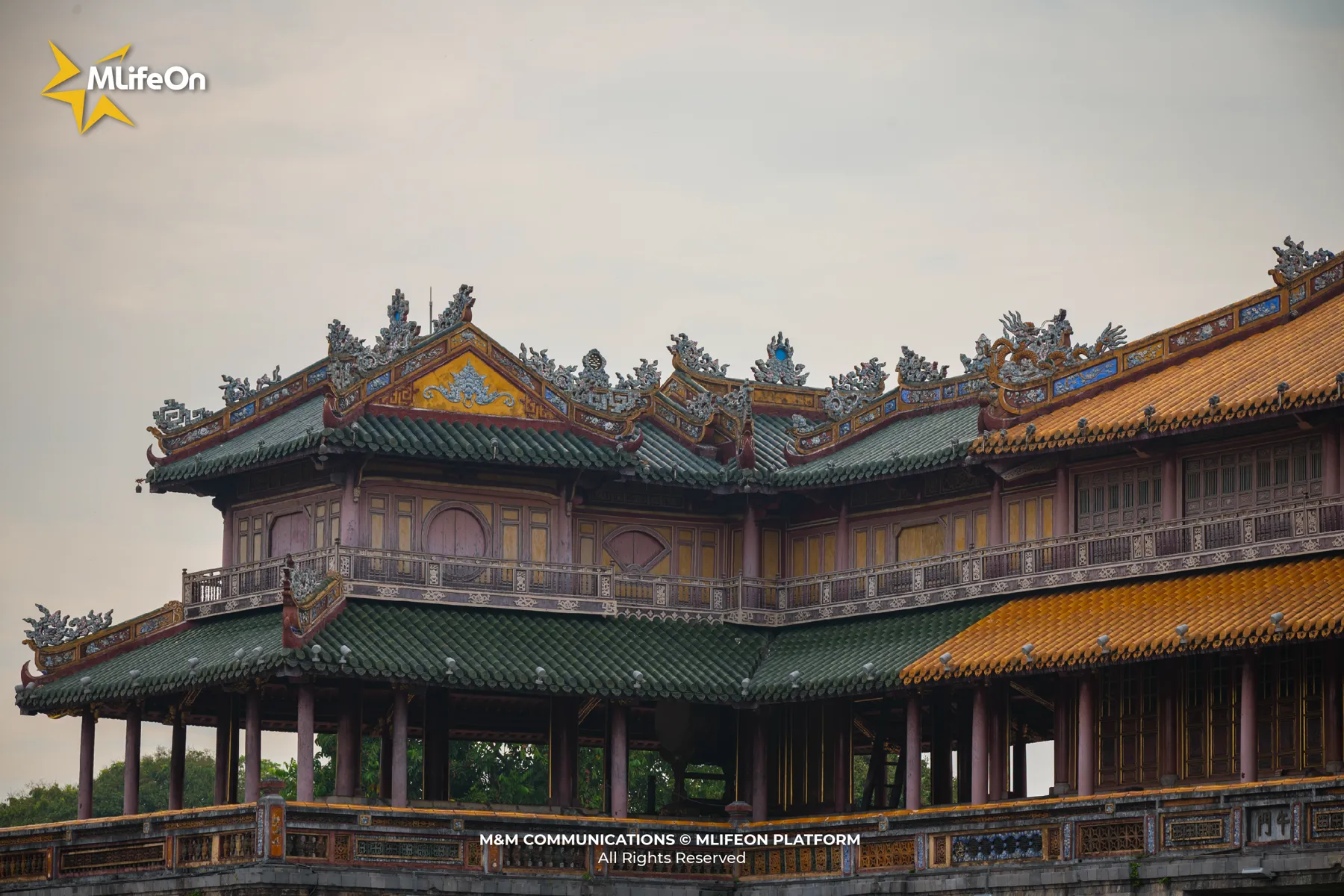
Hue Imperial City was built in 1804 under the reign of King Gia Long, as the administrative center and residence of the Nguyen Dynasty royal family. This project is located in the Complex of Hue Monuments, recognized by UNESCO as a World Cultural Heritage since 1993.
After being recognized by UNESCO, Hue Imperial City began to have many projects of restoration and reconstruction. The restored projects include: Thai Hoa Palace - which has undergone many restorations and repairs through the dynasties. Among them, the largest restoration, lasting three years (starting from 2021); The project with the most outstanding restoration in Hue Imperial City is Kien Trung Palace (from 2019 - 2024). After 5 years, this project was almost completely restored; In addition, many other projects in the Imperial City such as gateways, towers, communal houses, and temples are also periodically restored and repaired.
For more than 140 years of existence, Hue Imperial City is not only a historical site but also a symbol of power, art and royal culture of Vietnam. Having gone through many historical changes, this place still retains its majestic and ancient beauty and is a destination not to be missed when mentioning Hue.
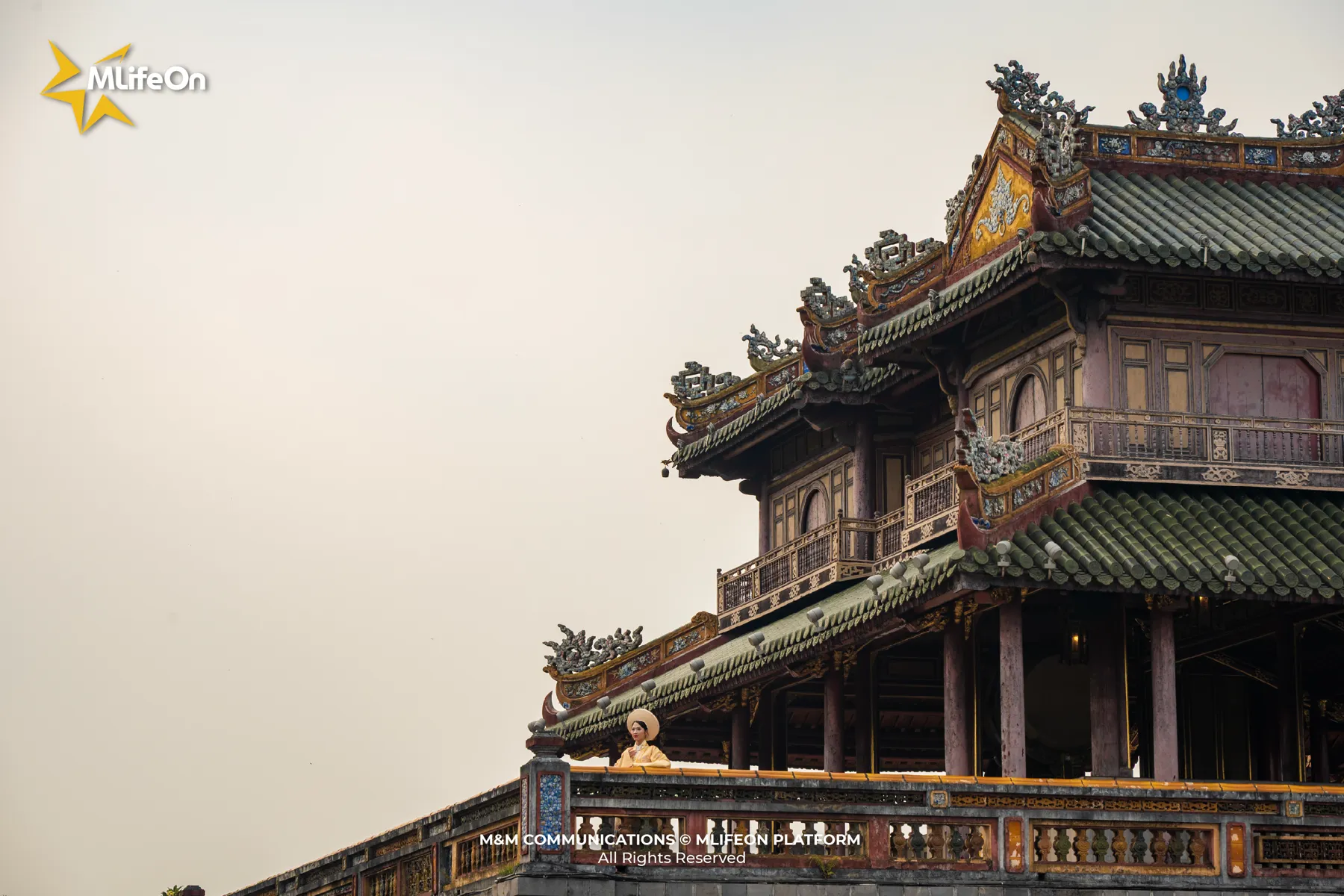
Typical works
The Hue Imperial City is a massive royal architectural complex, including the Imperial City and the Forbidden City, surrounded by a system of walls, moats and gates. Each work in the Imperial City not only has a separate function but also carries profound symbolic value, reflecting the philosophy of Eastern architecture and the spirit of the Vietnamese people.
Here are the outstanding works that anyone visiting Hue should take the time to visit and explore:
Ngo Mon - the gate of power
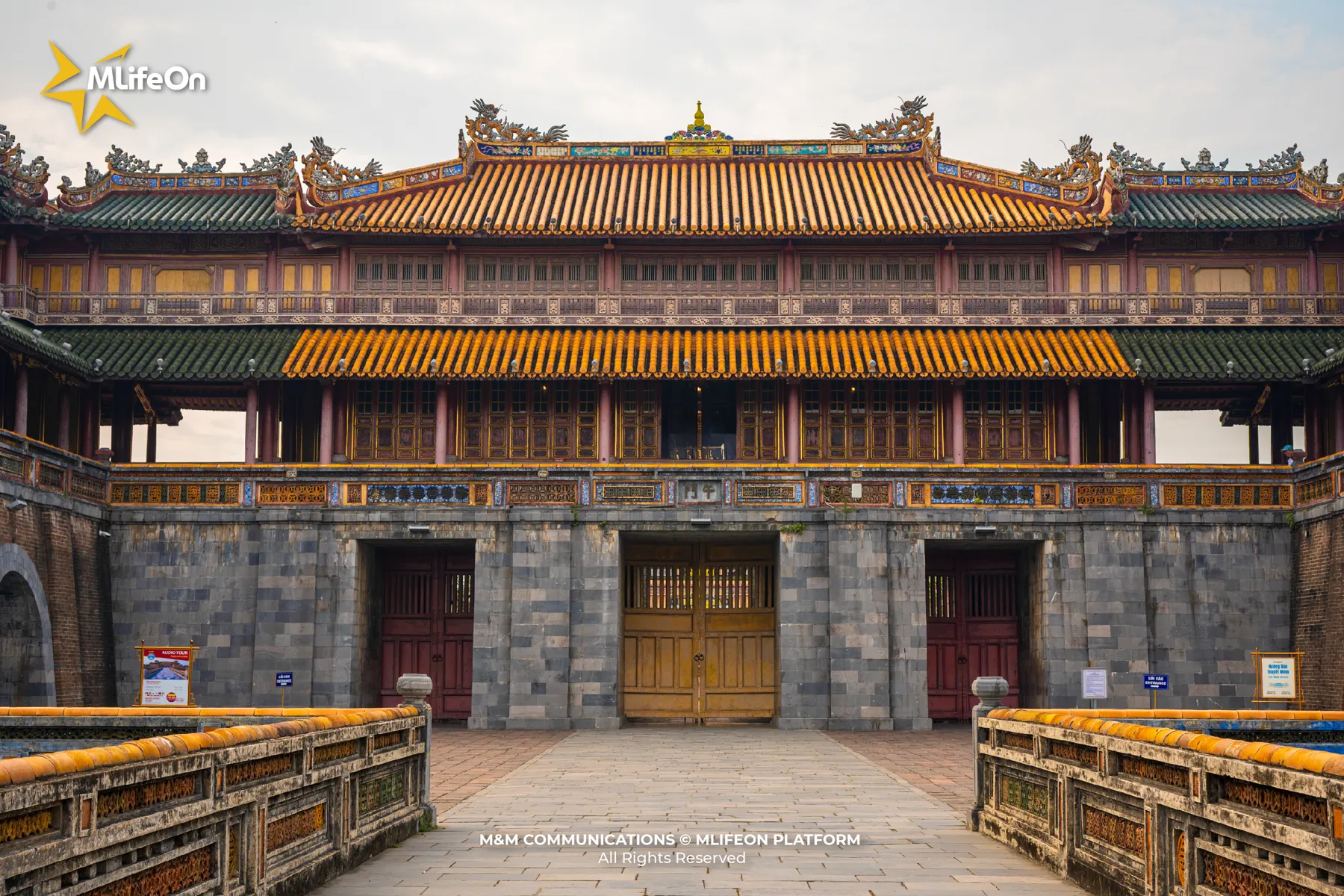
Ngo Mon Gate
Ngo Mon is the main southern gate of the Imperial City, built under the reign of King Minh Mang in 1833. This is not only where the king appeared in important ceremonies such as coronation, receiving ambassadors, but also a symbol of royal power. The structure consists of two parts: a high platform made of stone and brick, above is the Ngu Phung tower with a roof of royal tiles.
Thai Hoa Palace - the center of power
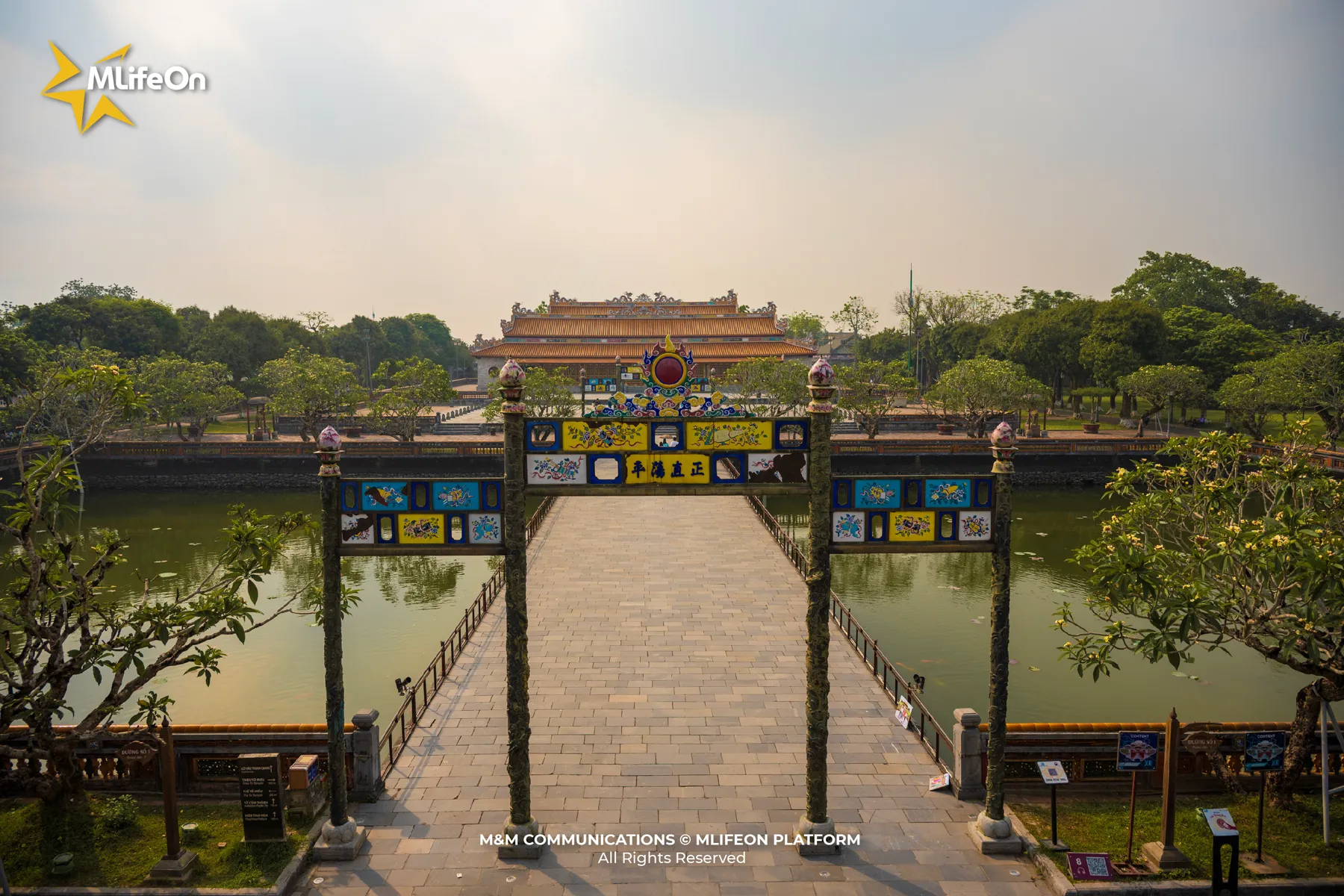
Điện Thái Hòa
Thai Hoa Palace is where the royal court meetings, receptions of envoys and major ceremonies are held. Built during the reign of King Gia Long, this structure is the center of the sacred axis - the main axis of the entire Imperial City. The palace is built of ironwood, the roof is covered with royal glazed tiles, the interior is decorated with dragon and phoenix patterns, expressing nobility and majesty.
When I stopped here, I felt like I was standing in the heart of a dynasty - where every word, every decision affected the fate of the nation.
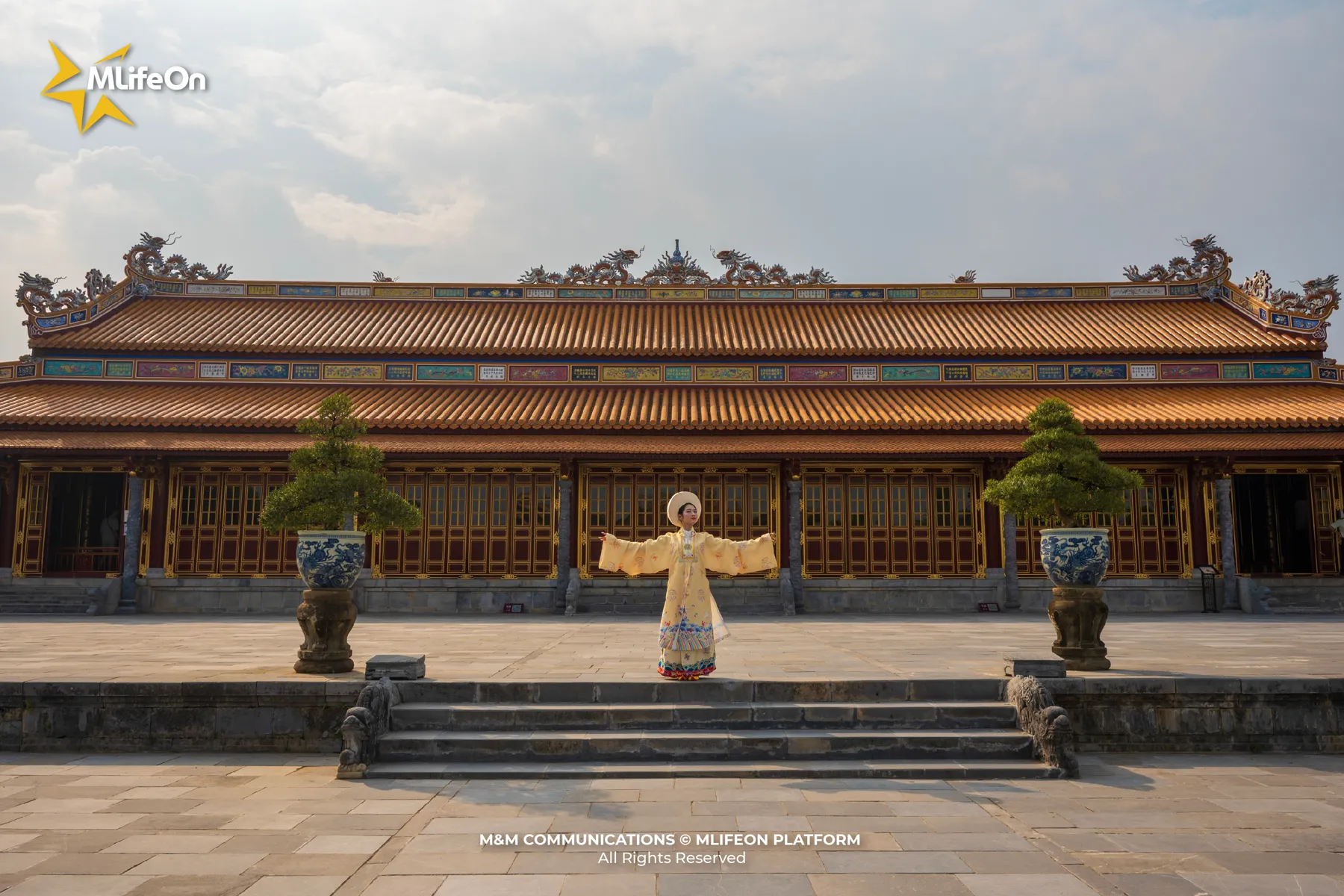
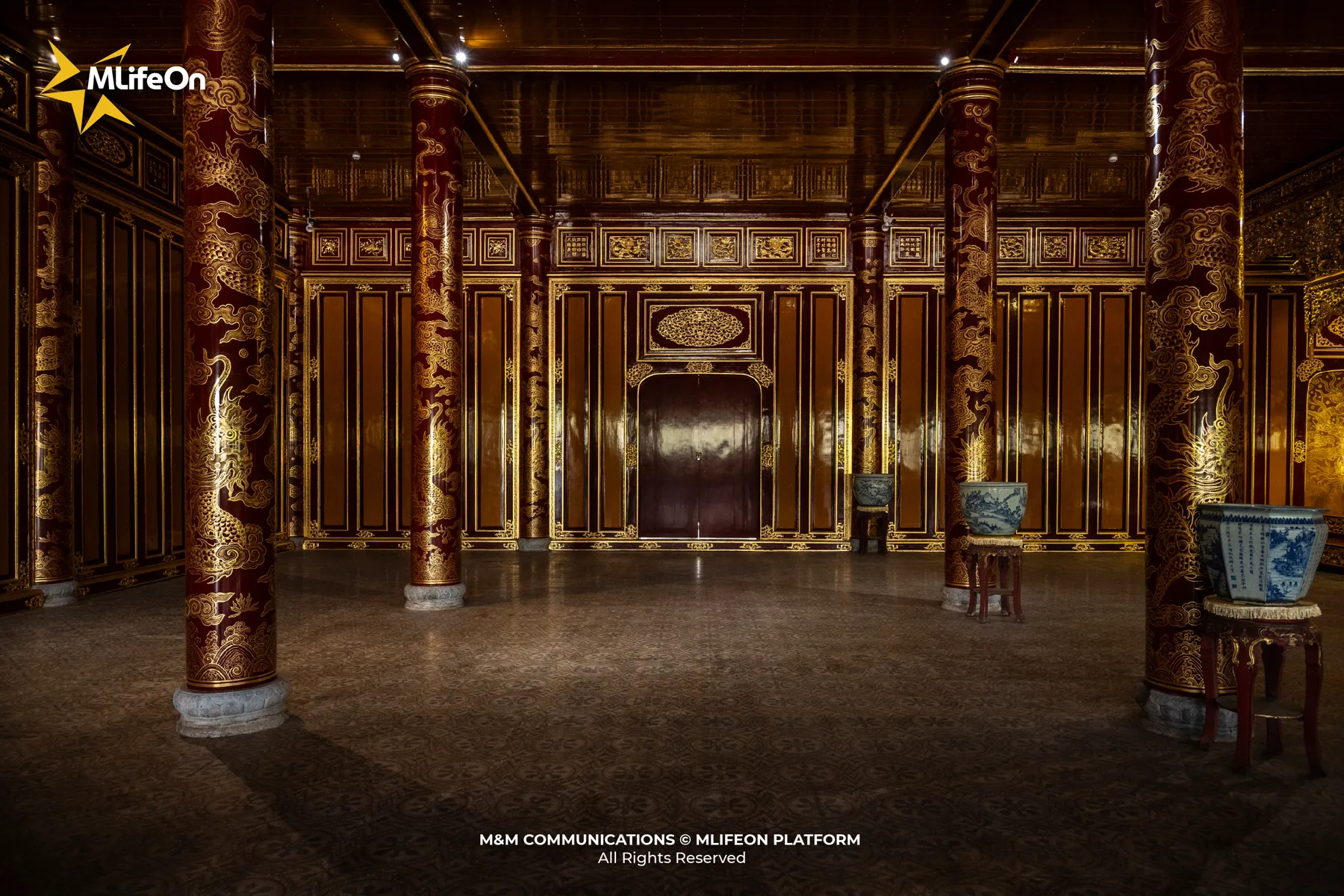
Inside Thai Hoa Palace
Forbidden City - private space of the royal family
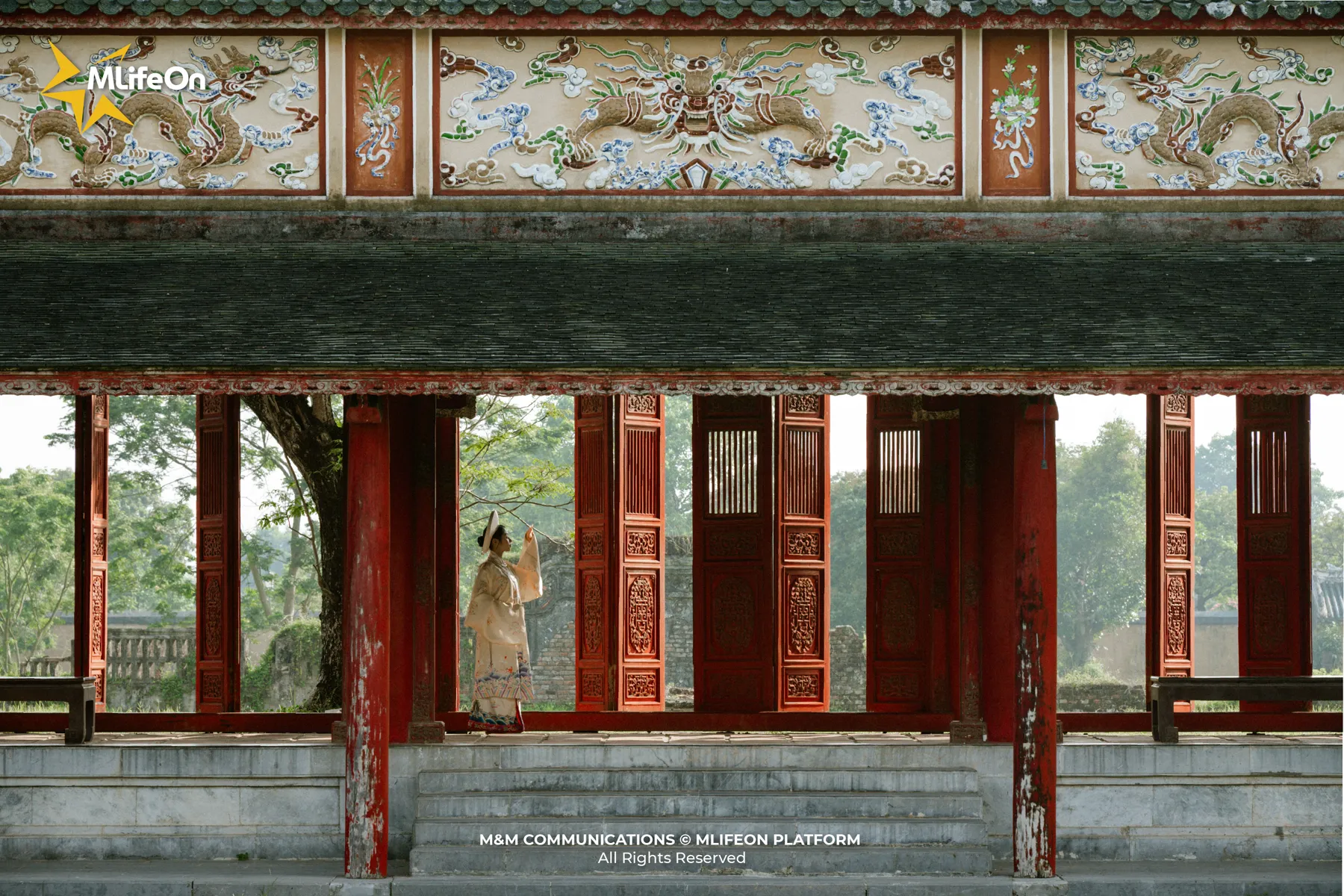
Forbidden City area
Located behind the Thai Hoa Palace, the Forbidden City is an area reserved for the king and the royal family. Strictly protected, this place used to be a private space, only for the royal family.
The Forbidden City consists of many palaces, buildings, and corridors connected together, creating a harmonious whole. Although it has gone through many changes, when I step in here, I still feel tranquility and solemnity - as if time is slowing down.
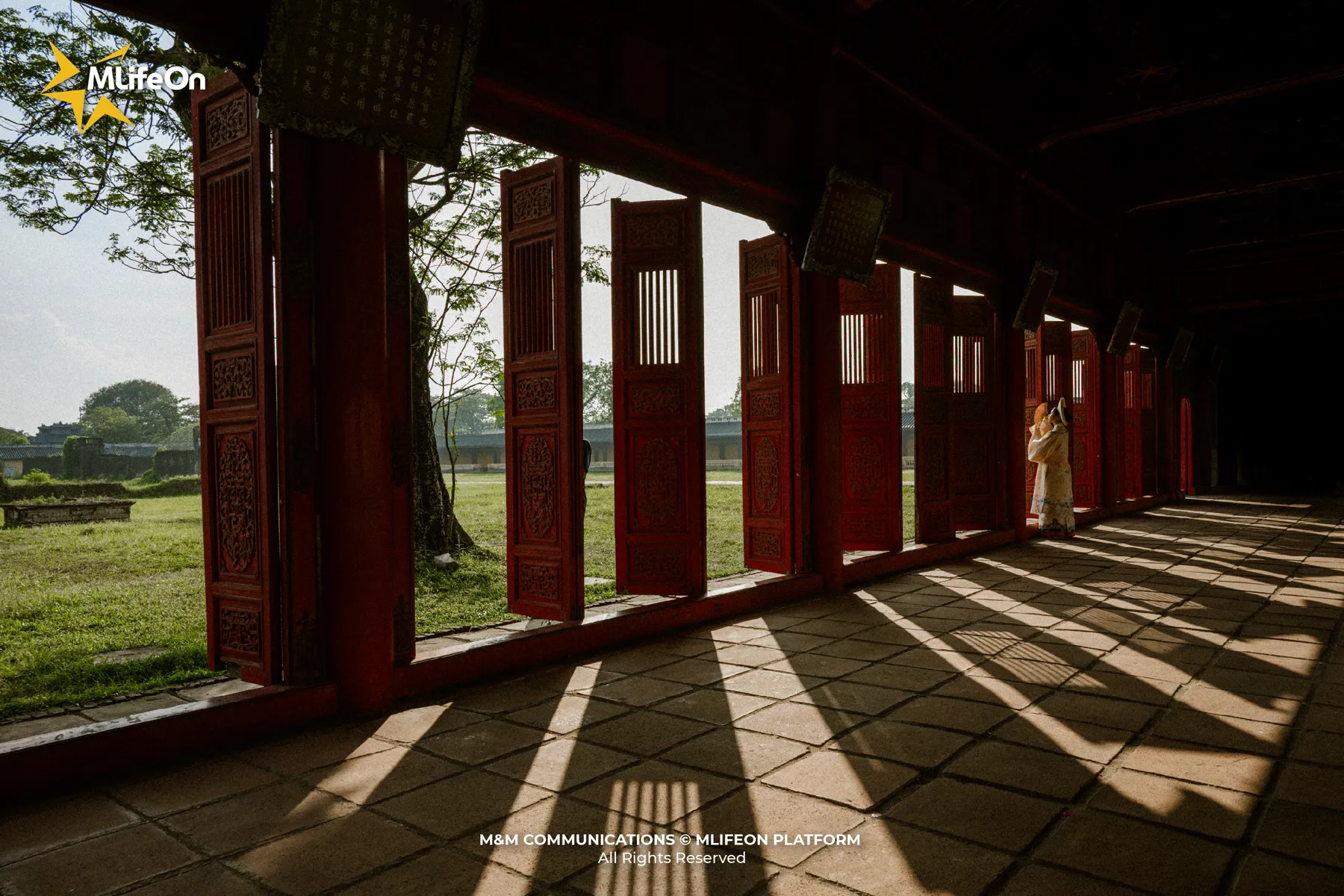
The Temple - a place to honor ancestors
The Temple of the Nguyen Dynasty is a place to worship the kings of the Nguyen Dynasty, showing respect to ancestors. Built during the reign of King Minh Mang, this is a sacred space, imbued with spiritual and religious elements.
Sharing the same area with The Temple of the Mieu are Hien Lam Pavilion and the Nine Urns - symbols of longevity and authority.
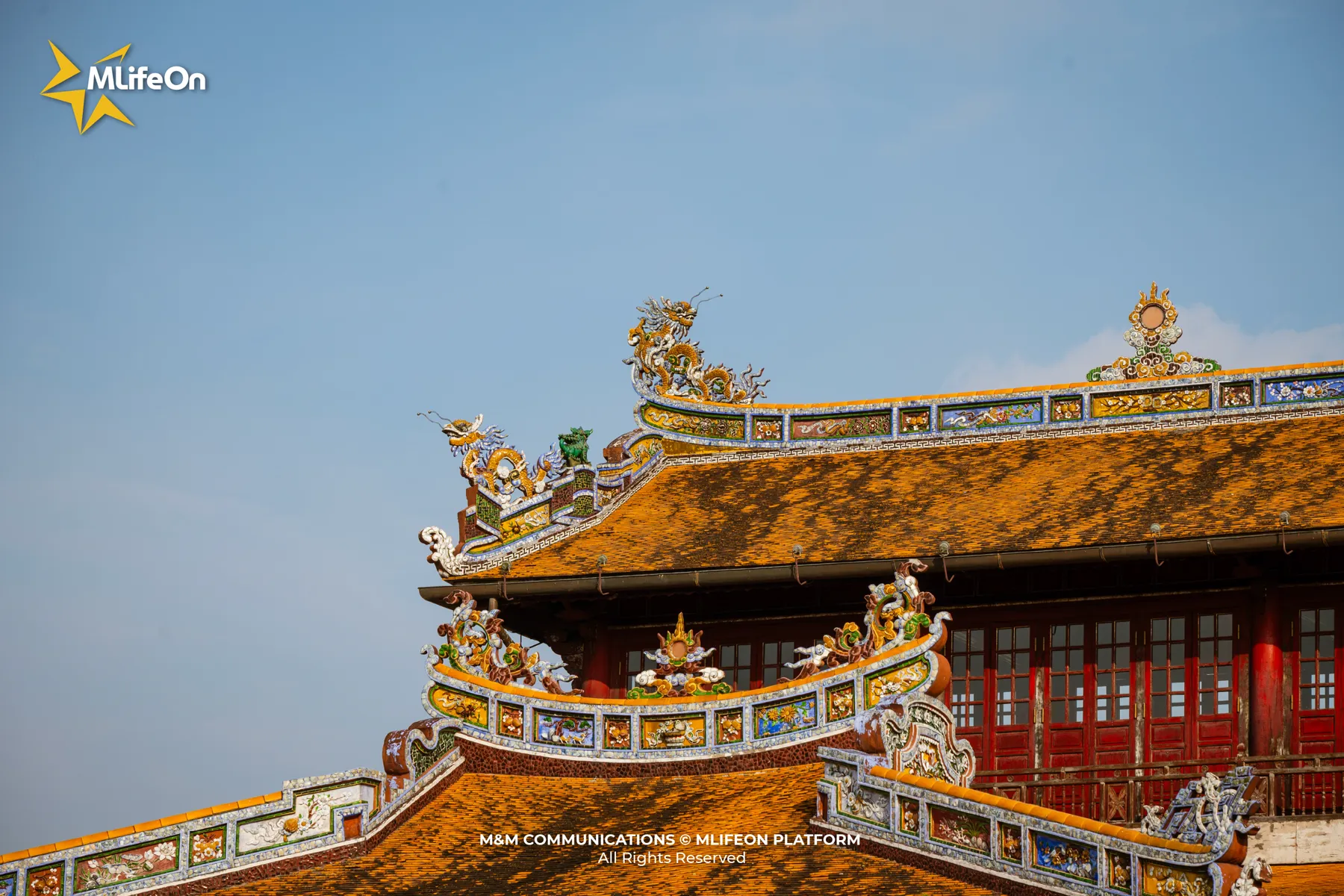
Hien Lam Pavilion
Kien Trung Palace - the intersection of East and West
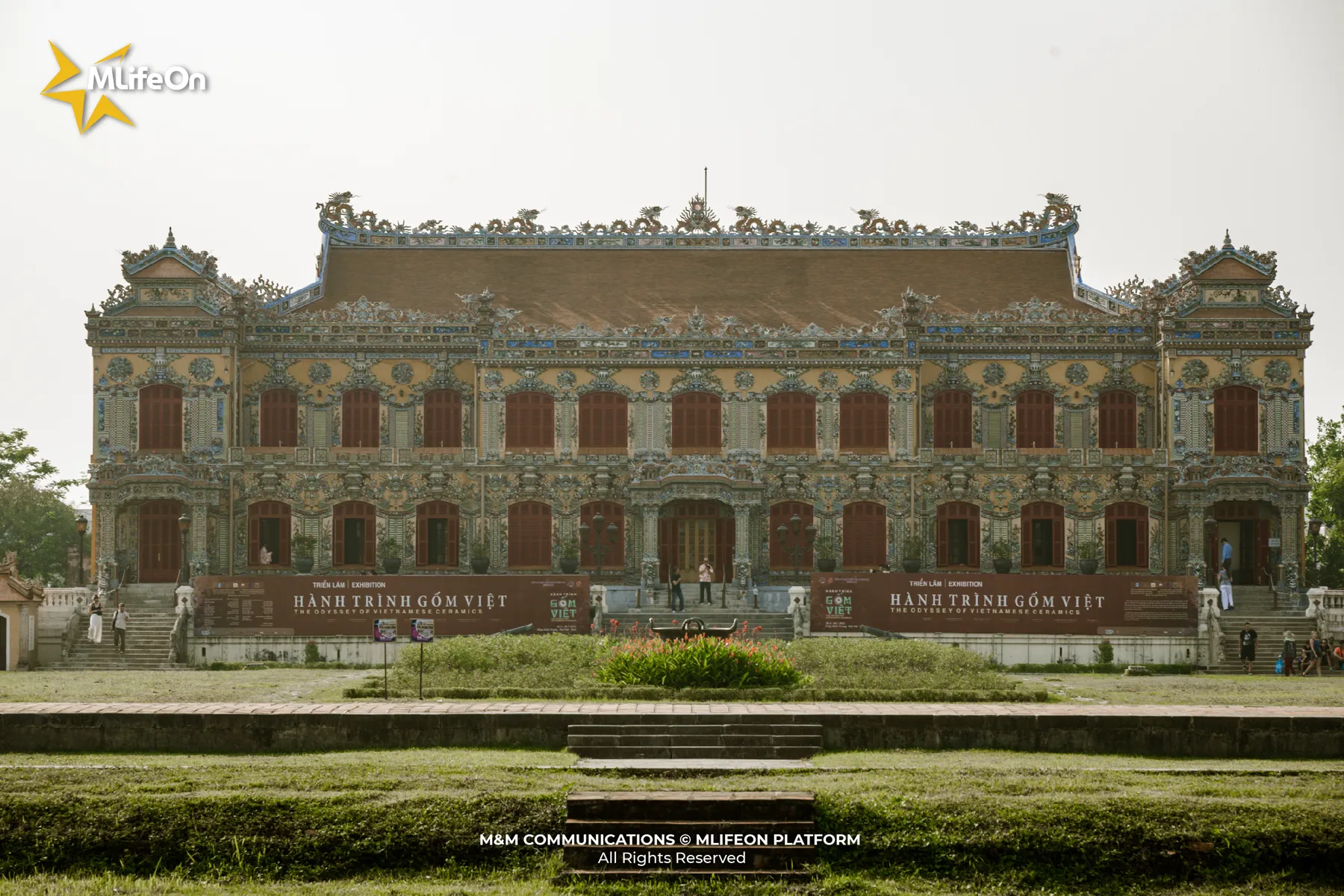
Kien Trung Palace
One of the most special buildings in the Hue Imperial City is Kien Trung Palace. Built under the reign of King Khai Dinh in 1921, Kien Trung Palace was where the king lived and worked in the last years of his life.
What makes this building stand out is the Asian-European architectural style: the frame has a French architectural style, but still retains traditional elements such as yin-yang tiled roofs and dragon and phoenix patterns. The interior was decorated with high-end materials such as marble, stained glass, and imported ceramic tiles.
Once I stood in front of Kien Trung Palace, looked up at the strange architectural details, and realized: this was not just a building, but the final exclamation point of a dynasty - where the past and the present intersect in each brick.
After many years of damage, Kien Trung Palace has been restored and reopened, becoming a new highlight in the journey to explore the Hue Imperial City.
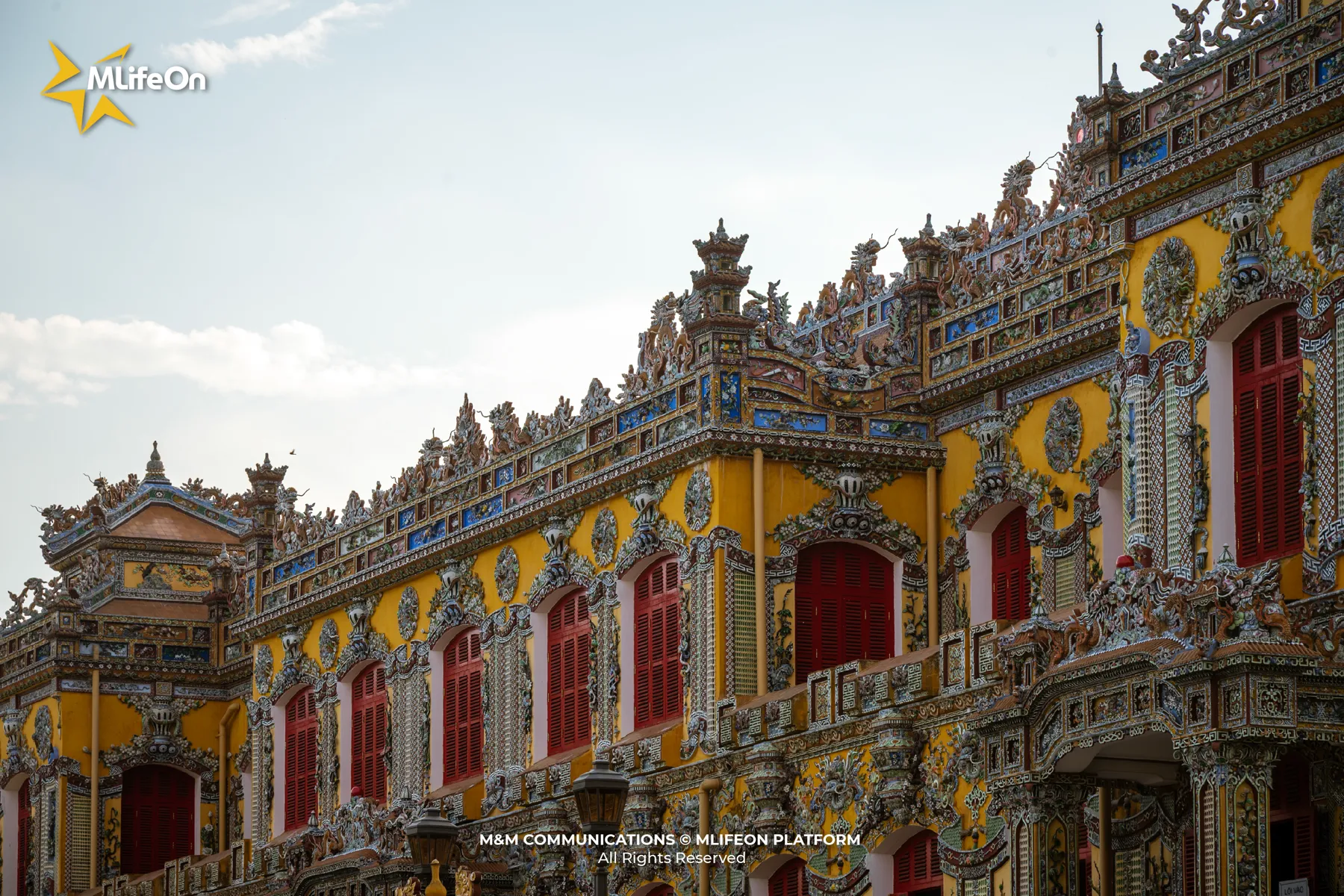
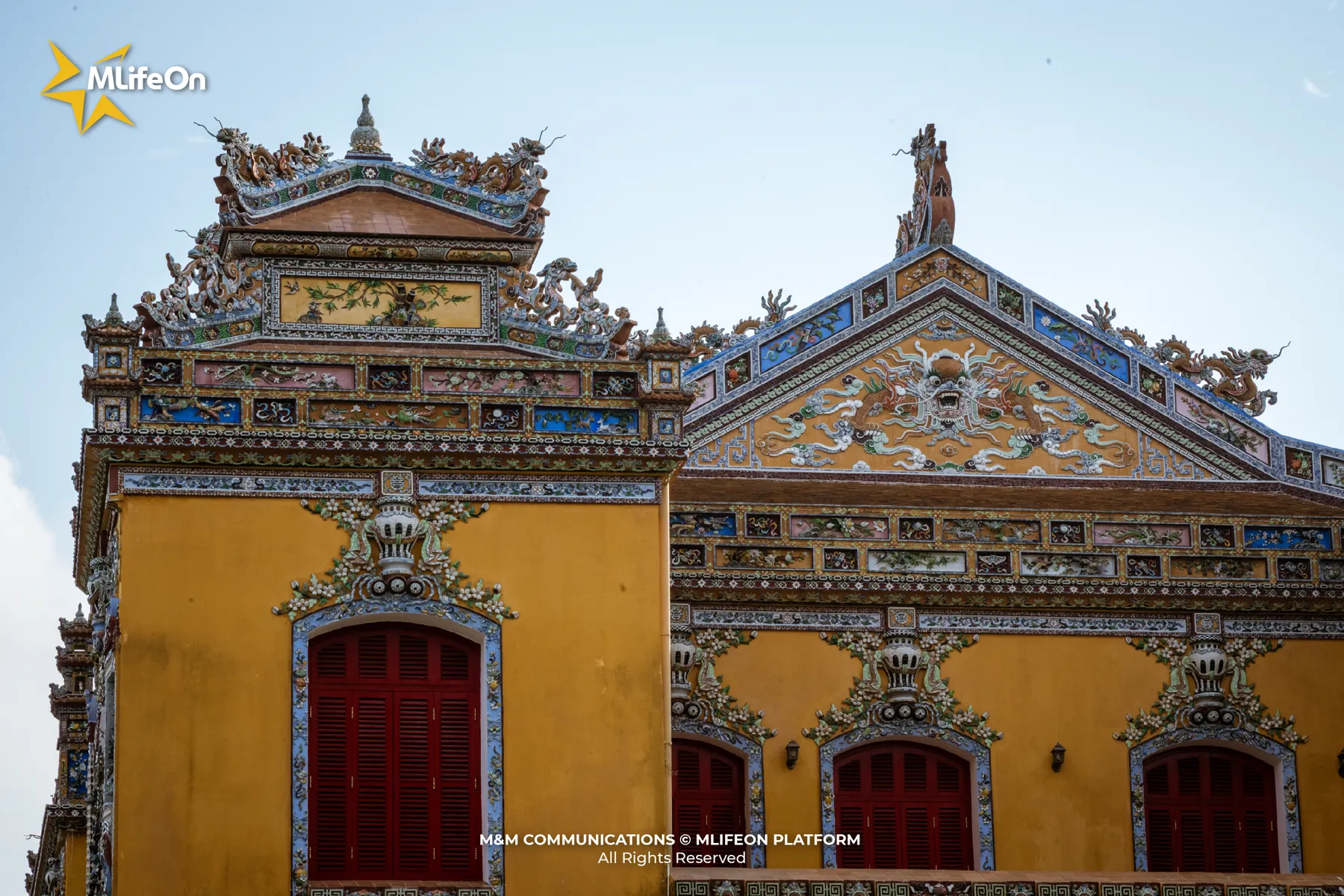
Where art and power meet
The Hue Imperial City not only makes people admire its scale or historical depth, but also its architectural features.
The architecture of the Hue Imperial City is not only a harmonious combination of traditional construction techniques and royal fine arts, but also the place that most clearly expresses the Eastern philosophy: balance, symmetry, solemnity and harmony with nature. Every detail in the Imperial City has a layer of symbolic meaning, making people not only admire but also contemplate.
Symmetry and the Divine Axis
The entire Imperial City was built along the North-South axis, with Ngo Mon as the starting point and Thai Hoa Palace as the center. This divine axis is not only an architectural axis, but also a spiritual axis, representing the connection between heaven - earth - people.
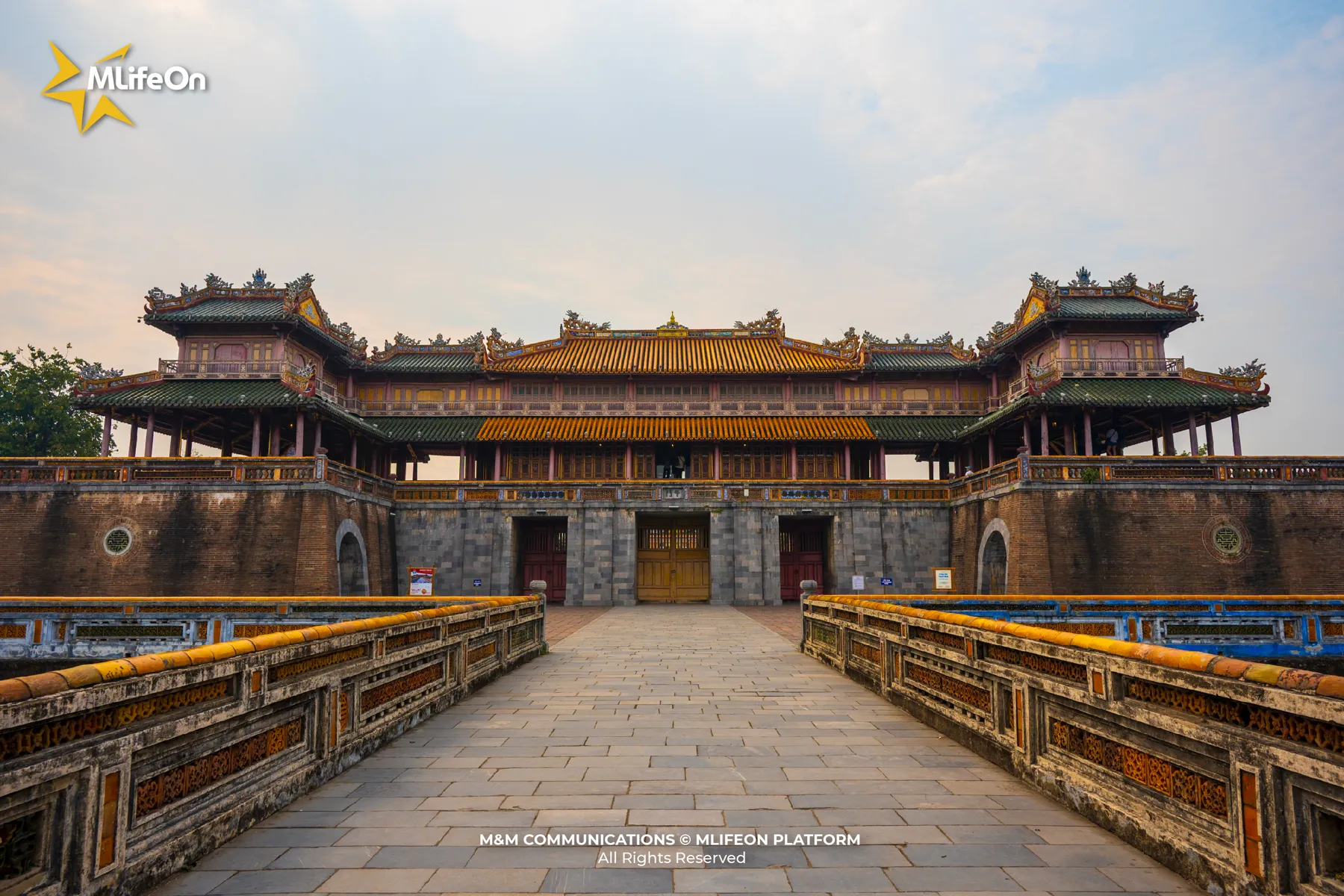
Symmetry is clearly shown in the works in Hue Imperial City.
Yin and Yang roof tiles - philosophy in each layer of tiles
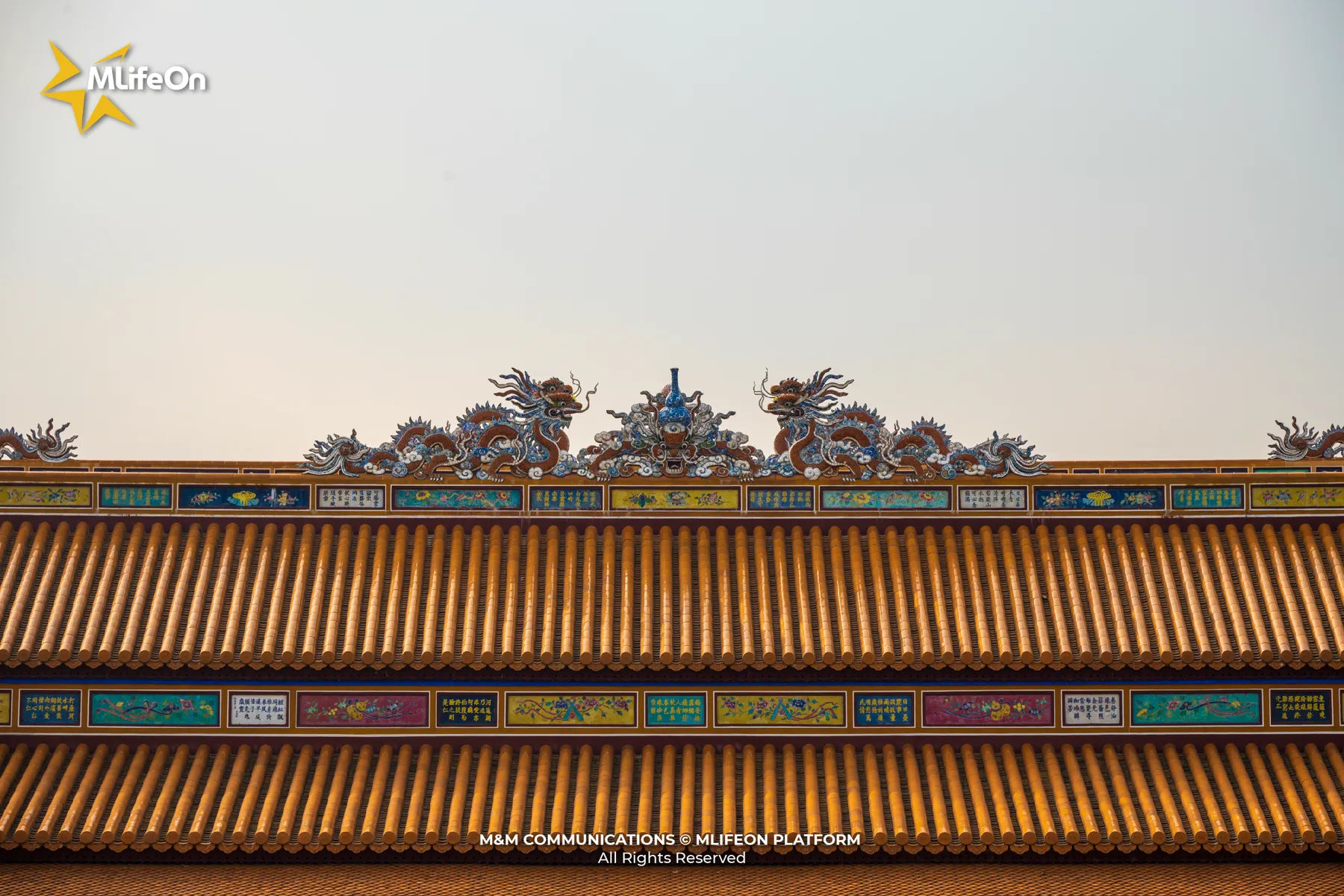
One of the outstanding features of the Imperial Citadel architecture is the yin-yang tile roof system. This type of tile consists of two parts: trough-shaped yin tiles and semicircular yang tiles, installed alternately. Not only does it help drain water well, the yin-yang tile roof also has a symbolic meaning: the harmony between yin and yang, between earth and sky, between humans and the universe.
When the sunlight shines down, each layer of tile sparkles like dragon scales, creating a beauty that is both ancient and vibrant.
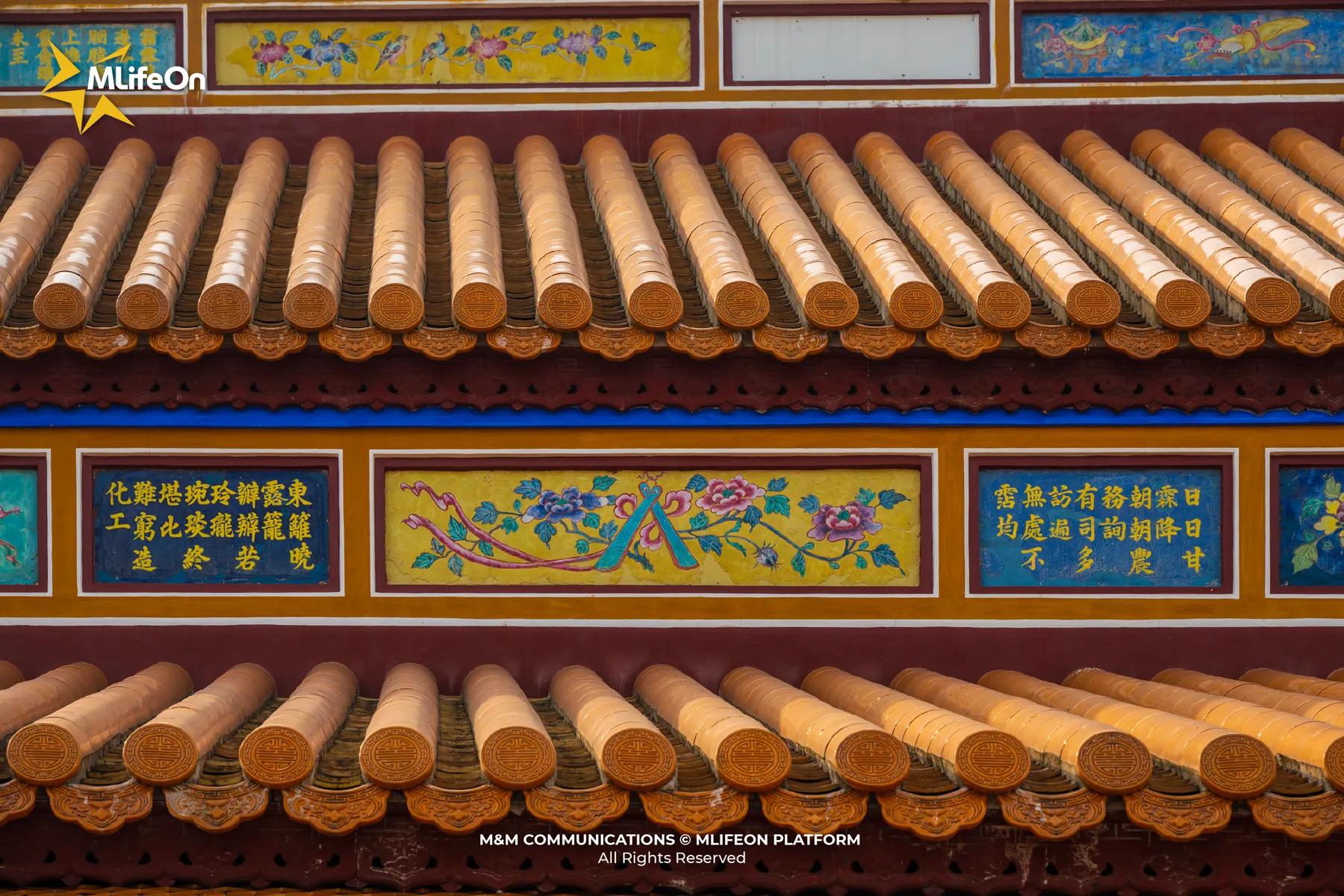
Ceramic mosaic technique - art from broken pieces
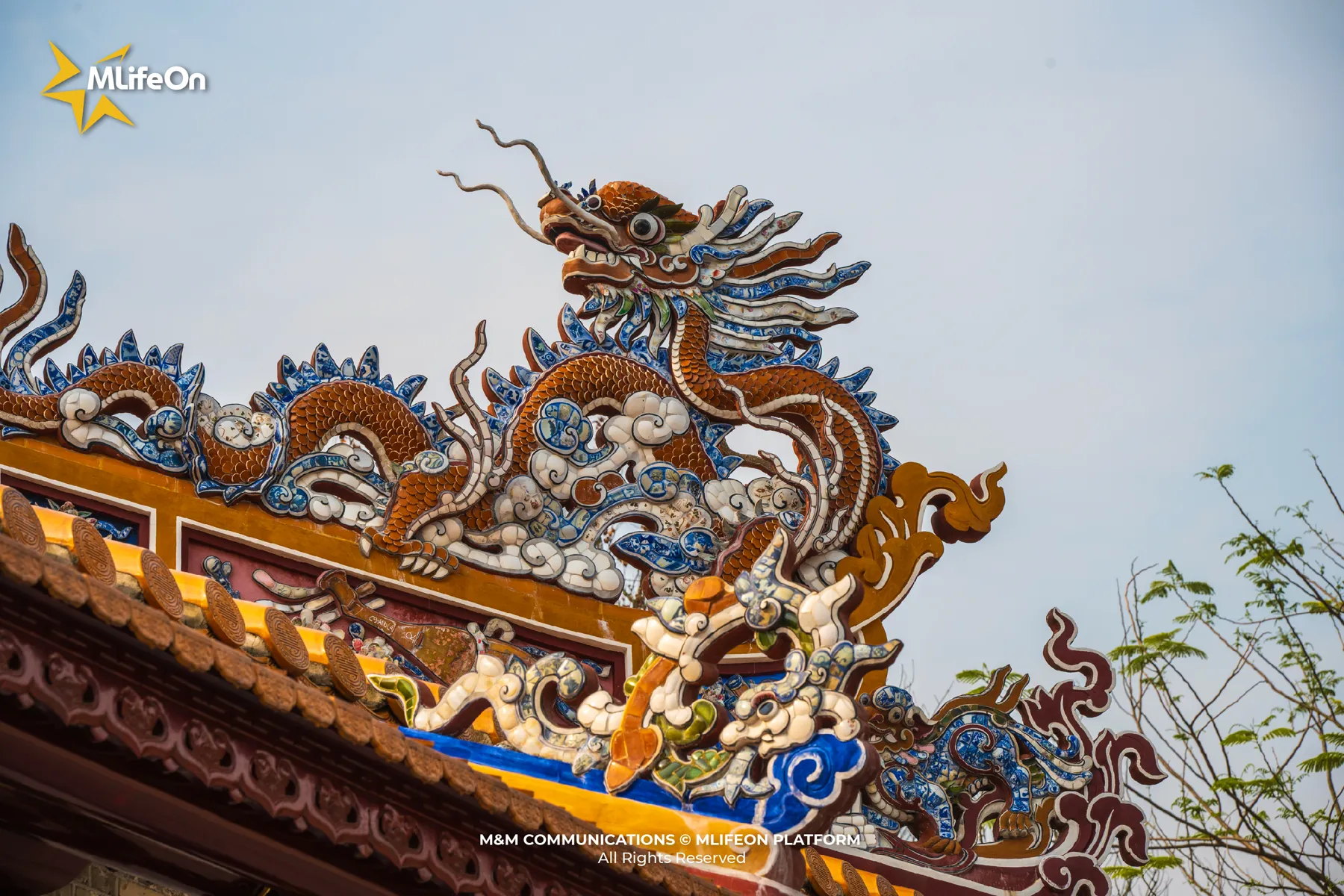
The dragon image is inlaid with porcelain on the roof tiles.
Another unique feature is the ceramic mosaic technique on constructions such as Ngu Phung tower, Thai Hoa palace, Hien Lam Cac... Artisans used broken pieces of ceramic and colored glaze to create sophisticated decorative paintings: dragons, phoenixes, flowers, leaves, Chinese characters...
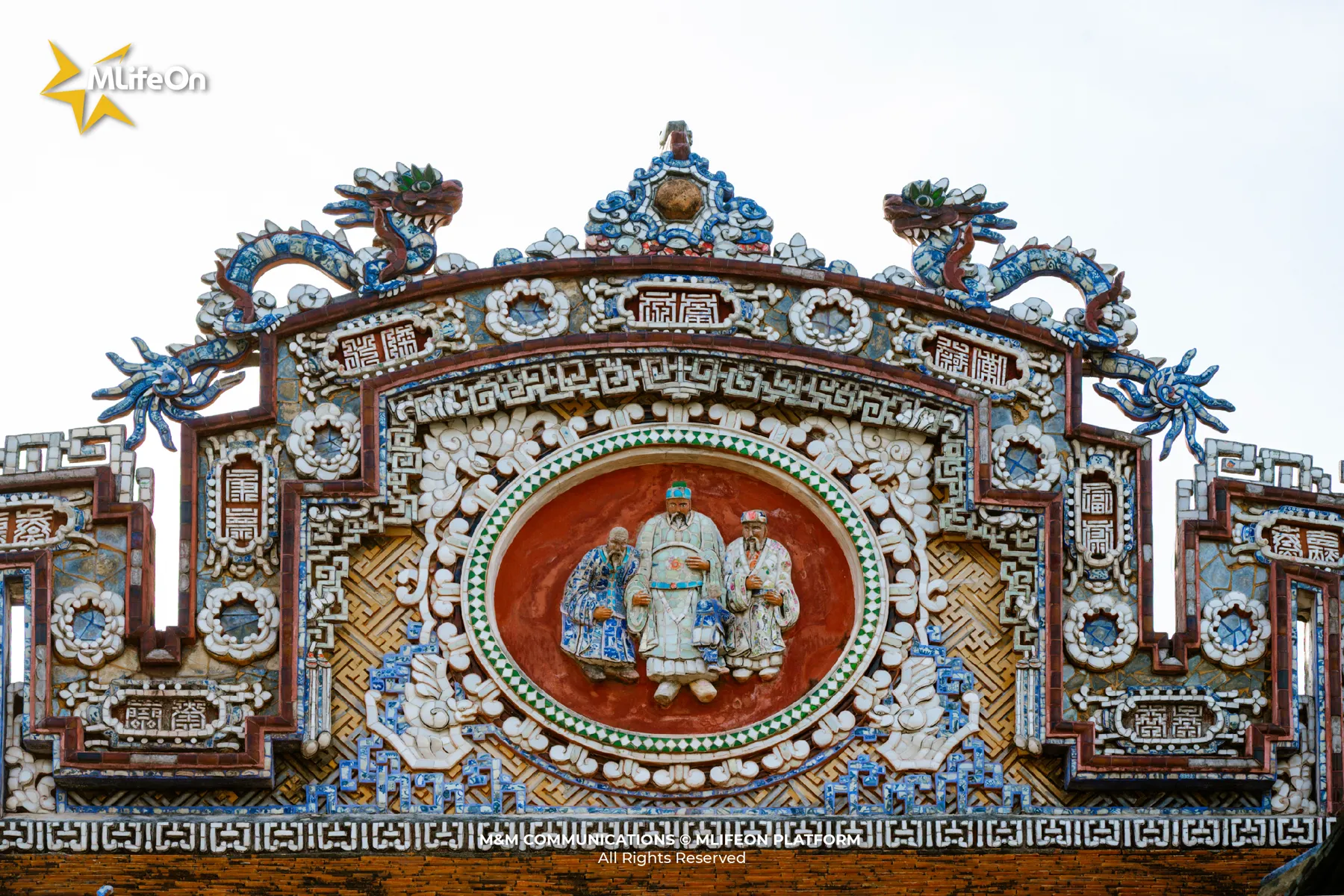
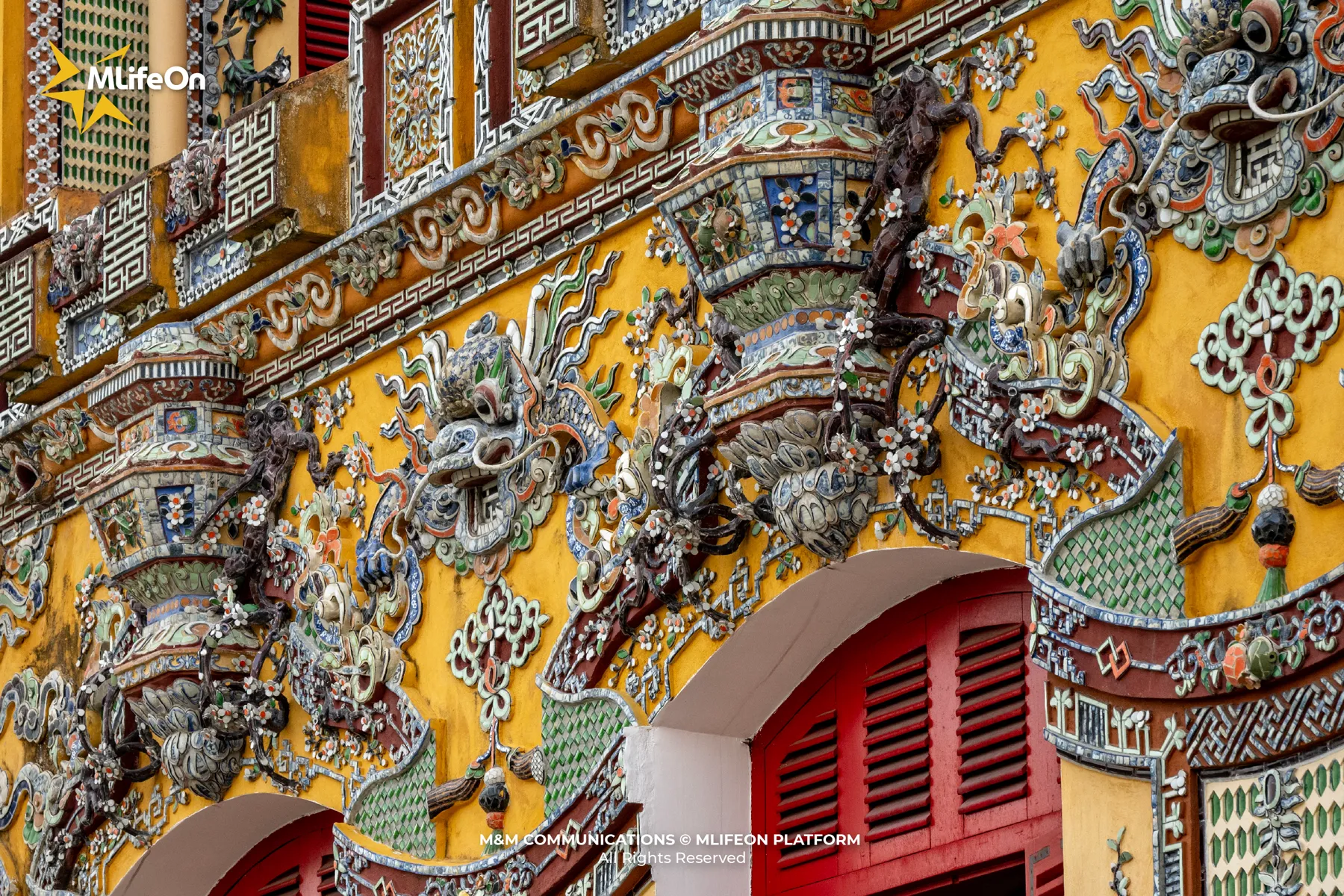
The technique of ceramic mosaic not only requires skill, but also demonstrates the unique aesthetic thinking of the ancients: turning broken things into eternal beauty.
Dragon image of Nguyen Dynasty
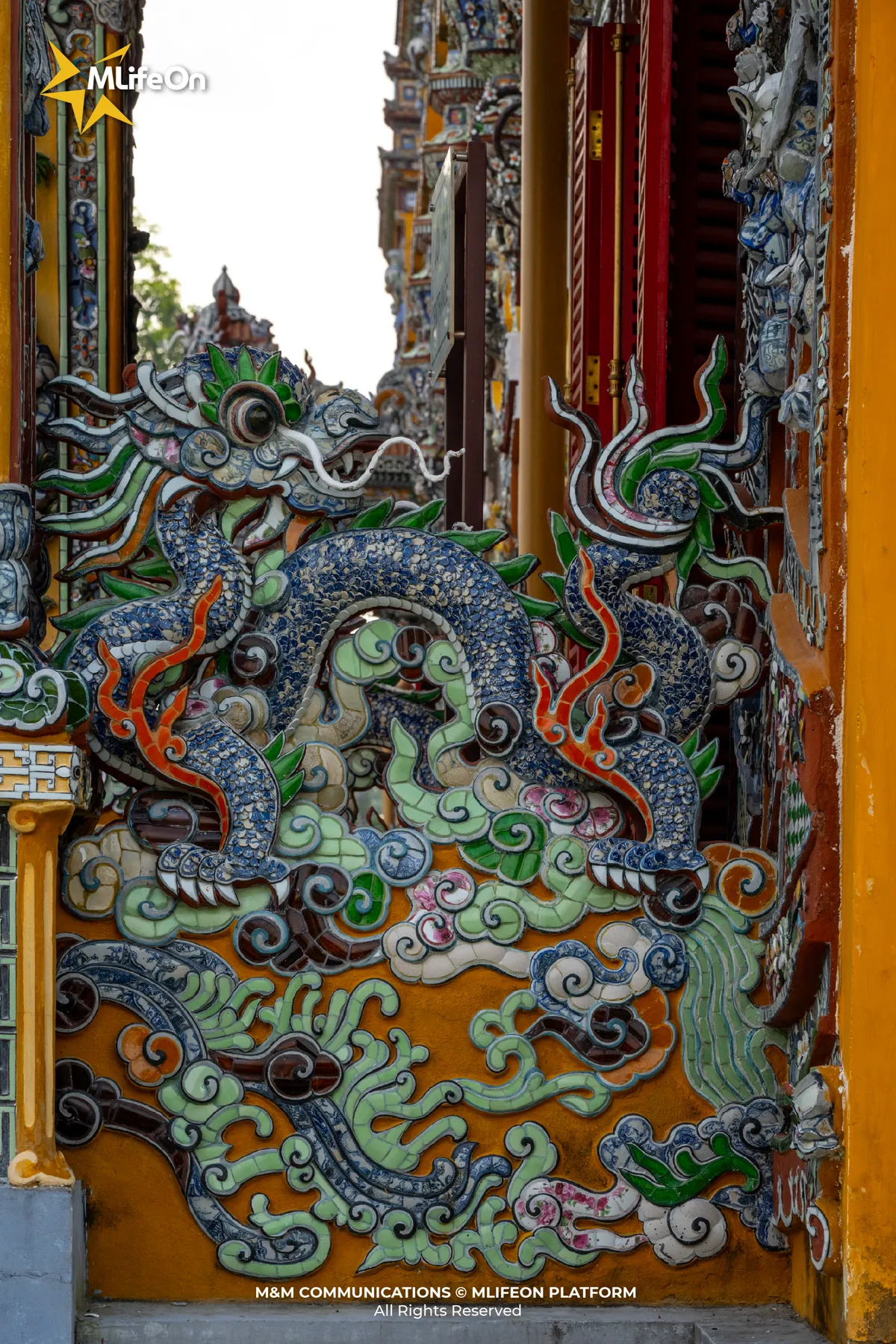
Dragons are a mascot that appears frequently in the architecture of the Hue Imperial City, but the dragons of the Nguyen Dynasty have their own characteristics: long, winding bodies, high heads, wide open mouths, no horns, often accompanied by clouds or water. The dragon is not only a symbol of the emperor, but also represents intelligence, majesty and protective power.
You can see the image of the dragon on tiled roofs, gables, wooden columns, screens... In each place, the dragon has a different appearance, but all exude the spirit of a dynasty that once ruled the world.
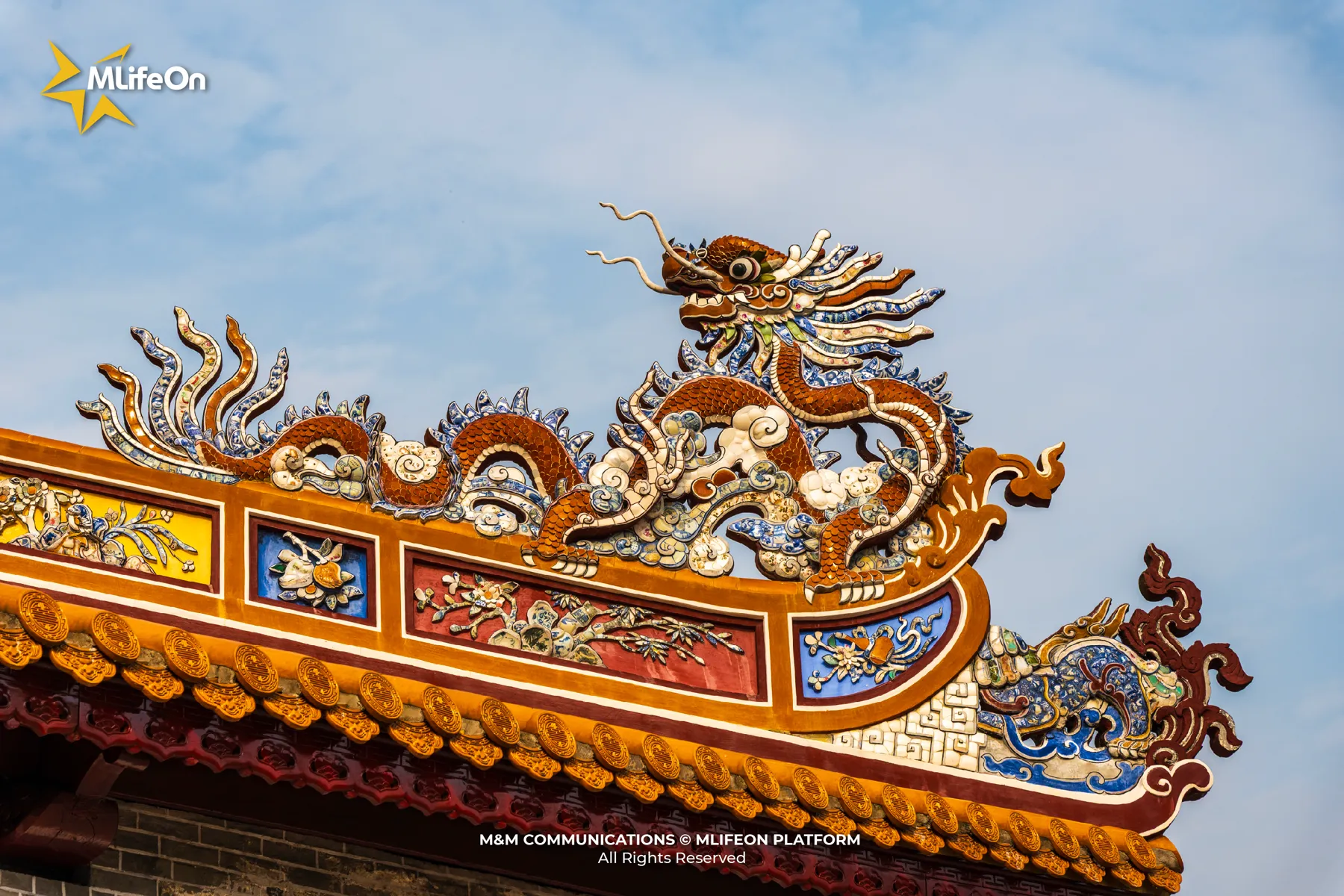
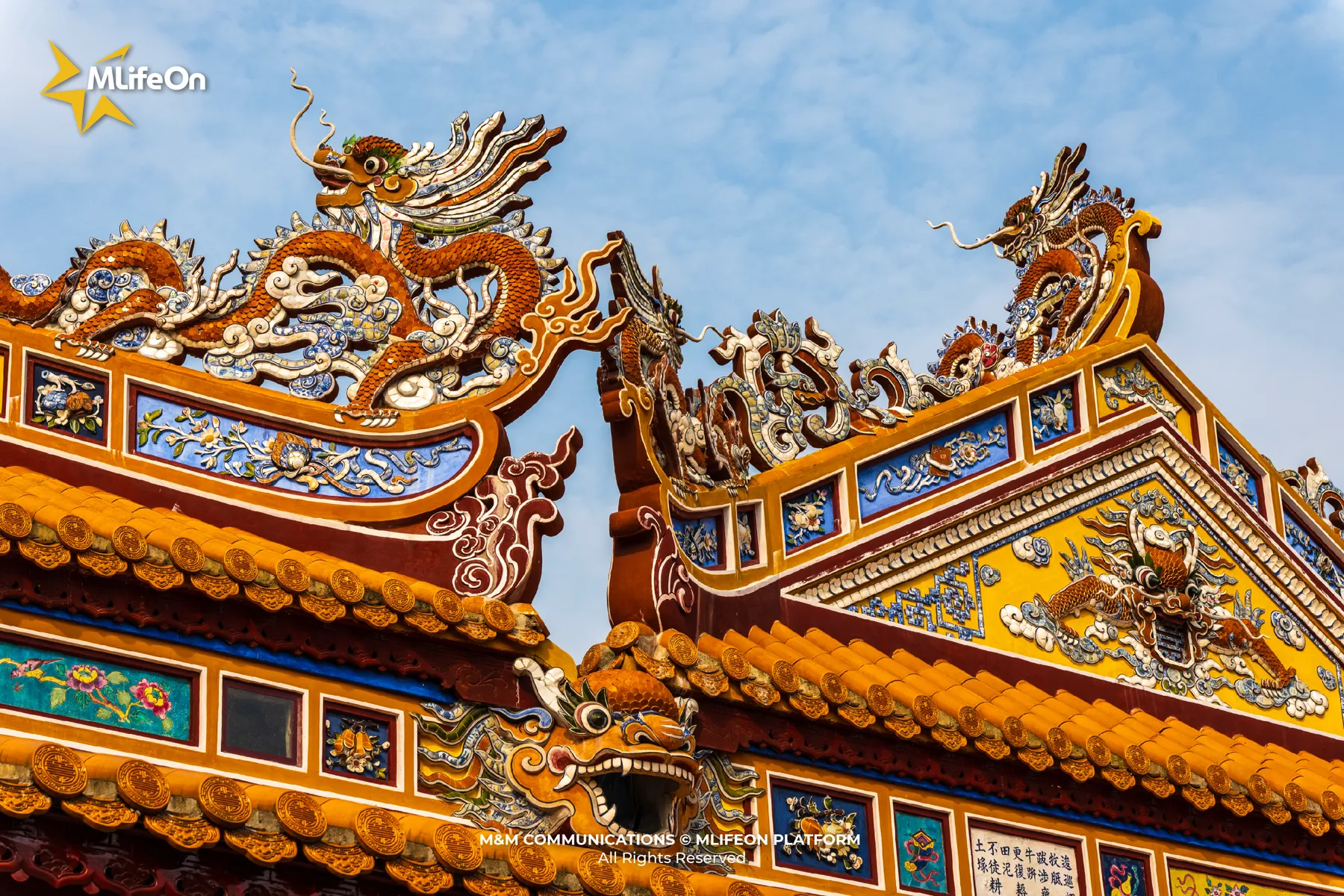
The image of a bat brings good luck
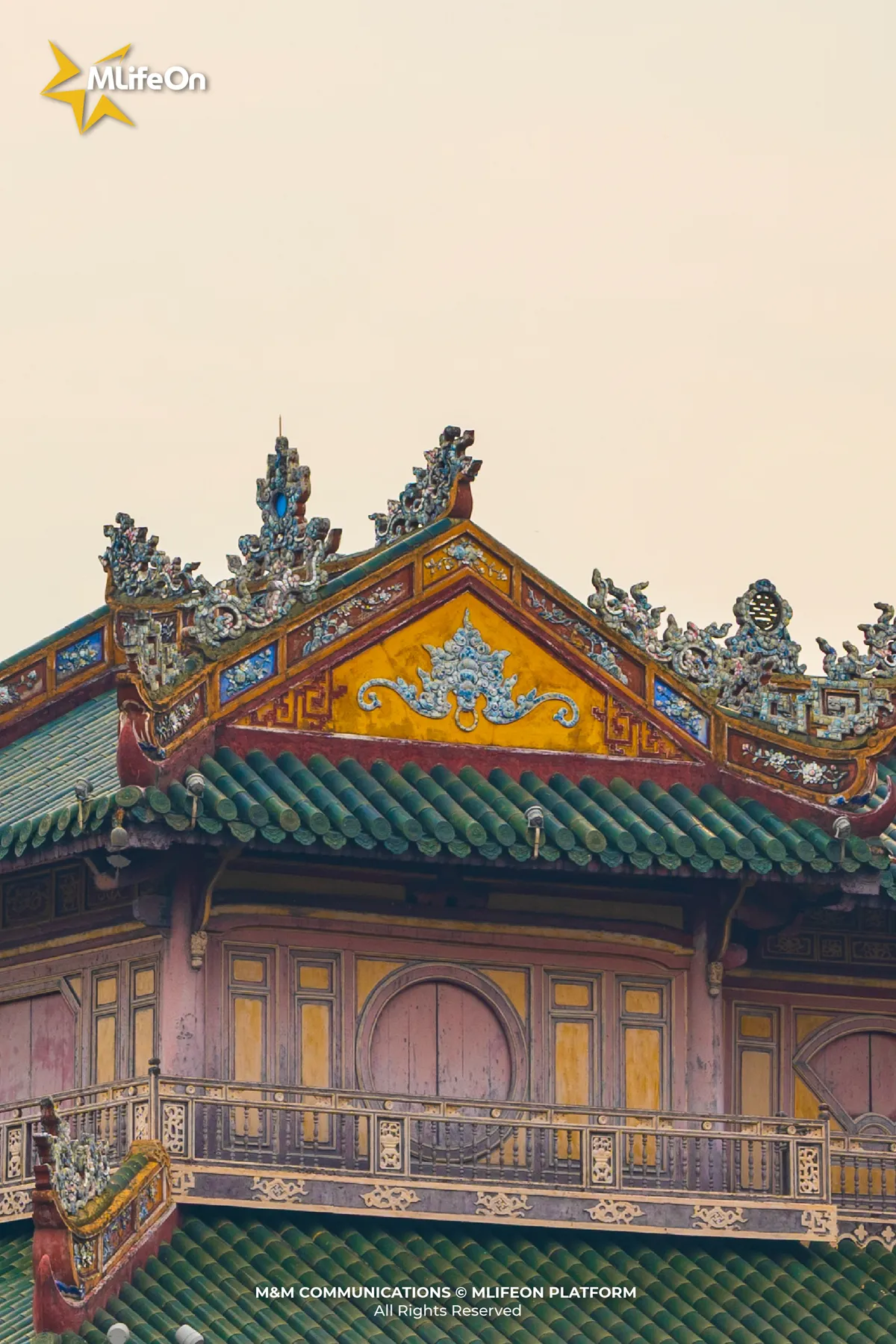
An interesting detail that few people notice is that the word “Phuc” in Hue Imperial City is often represented by the image of a bat. In Sino-Vietnamese culture, “dổi” sounds similar to “phúc”, so the bat becomes a symbol of luck, happiness and prosperity.
The image of a bat often appears on door frames, eaves, decorations… flying around the Chinese character, creating a space that is both solemn and warm. That is how the ancients expressed their wishes for a peaceful and fulfilling life - even in the royal palace.
Open space and harmony with nature
Although it is a royal palace, Hue Imperial City still maintains harmony with nature: lakes, gardens, brick courtyards… creating a majestic and poetic whole.
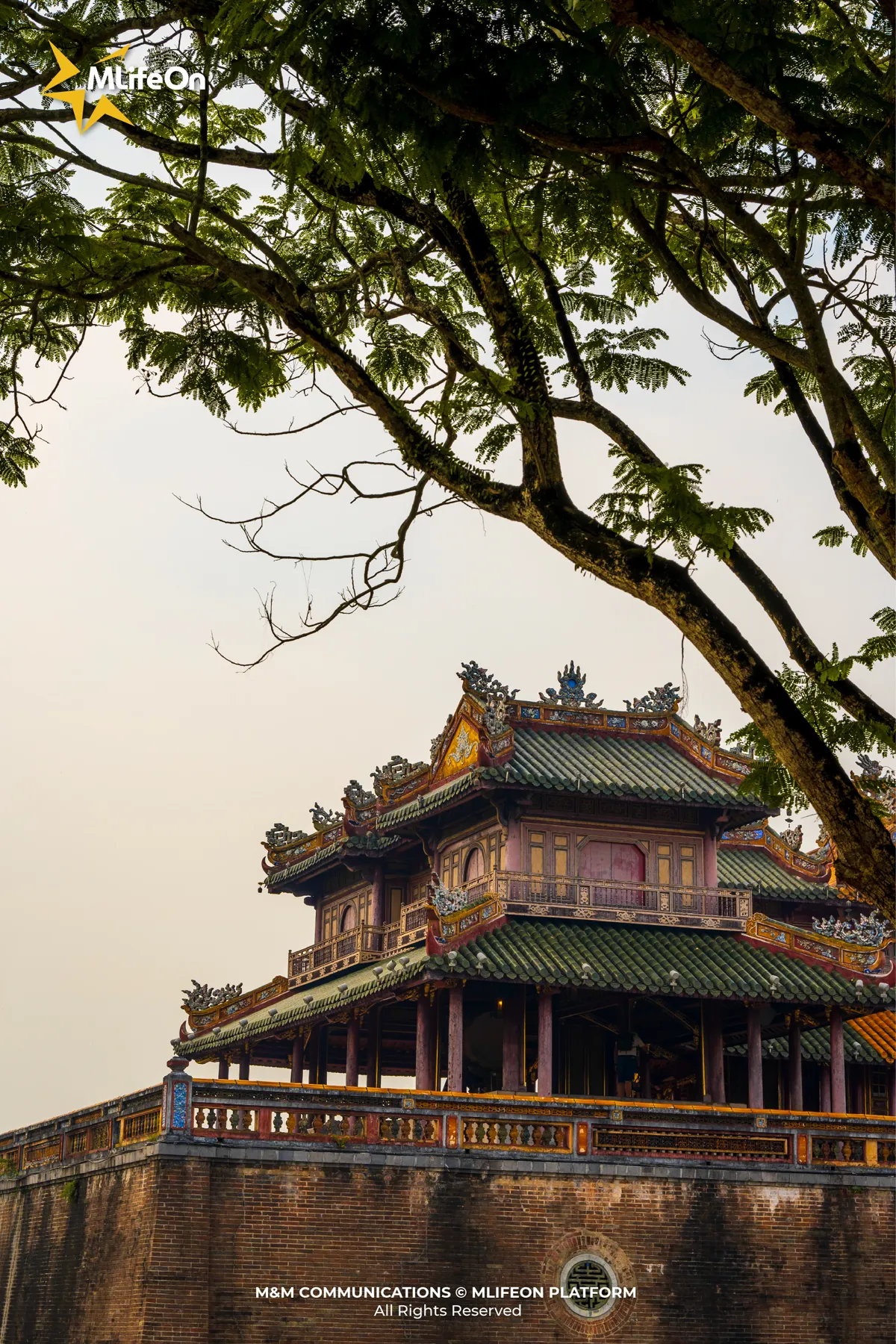
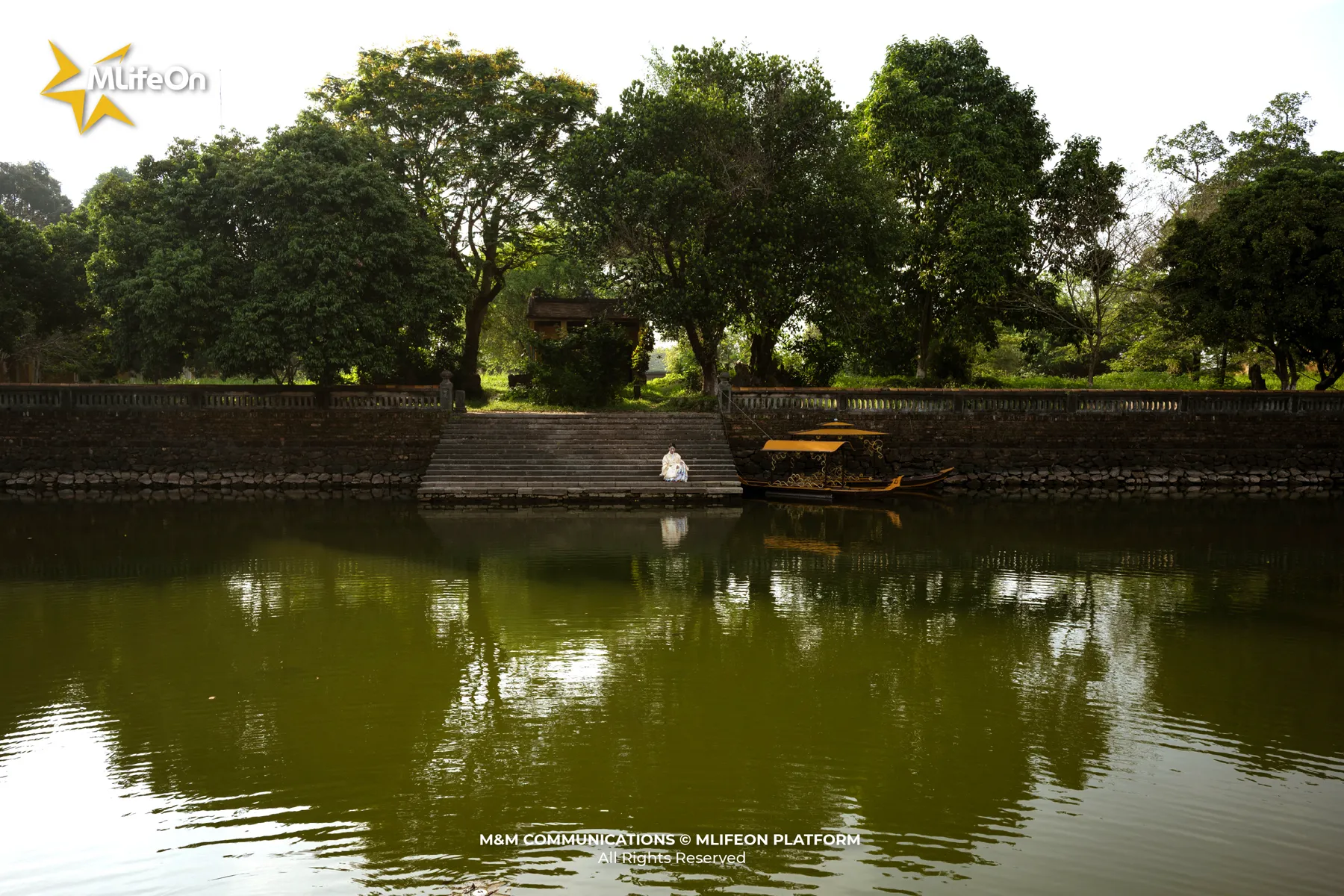
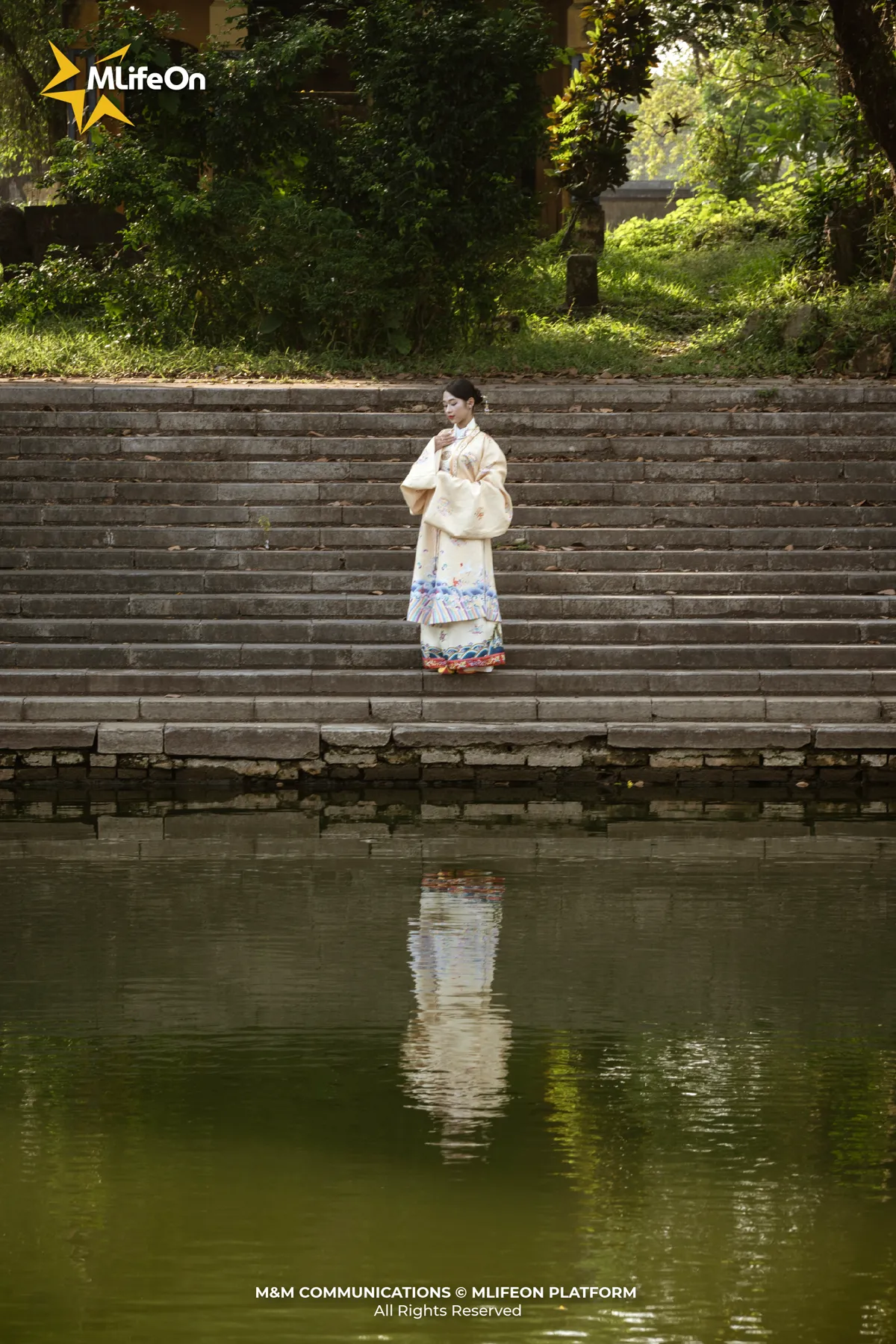
This is the point that makes me feel most comfortable when walking in Hue Imperial City - not stuffy, but like being lost in a fairy garden.
Cultural significance
The Hue Imperial City is not only the residence of the king, but also the cultural, artistic and religious center of an entire dynasty. Here, royal ceremonies, royal music, royal costumes... are all preserved and developed.
UNESCO's recognition of the Hue Imperial City as a World Cultural Heritage is not only a recognition of its architectural value, but also an affirmation of the importance of this place in the flow of Vietnamese culture.
Every step in the Imperial City is a step through history - where the past is not only retold, but also brought back to life through each wall and each tiled roof.
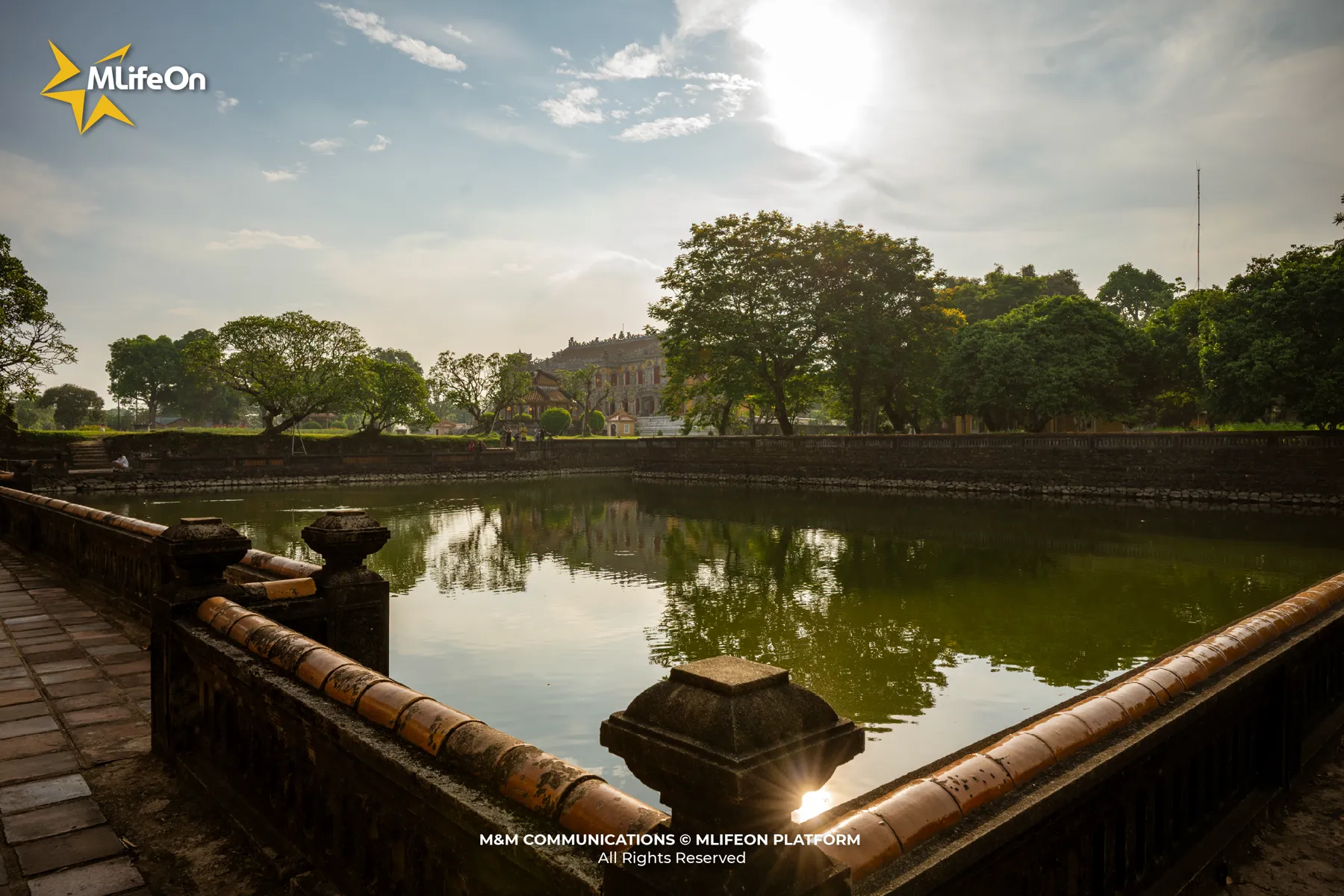
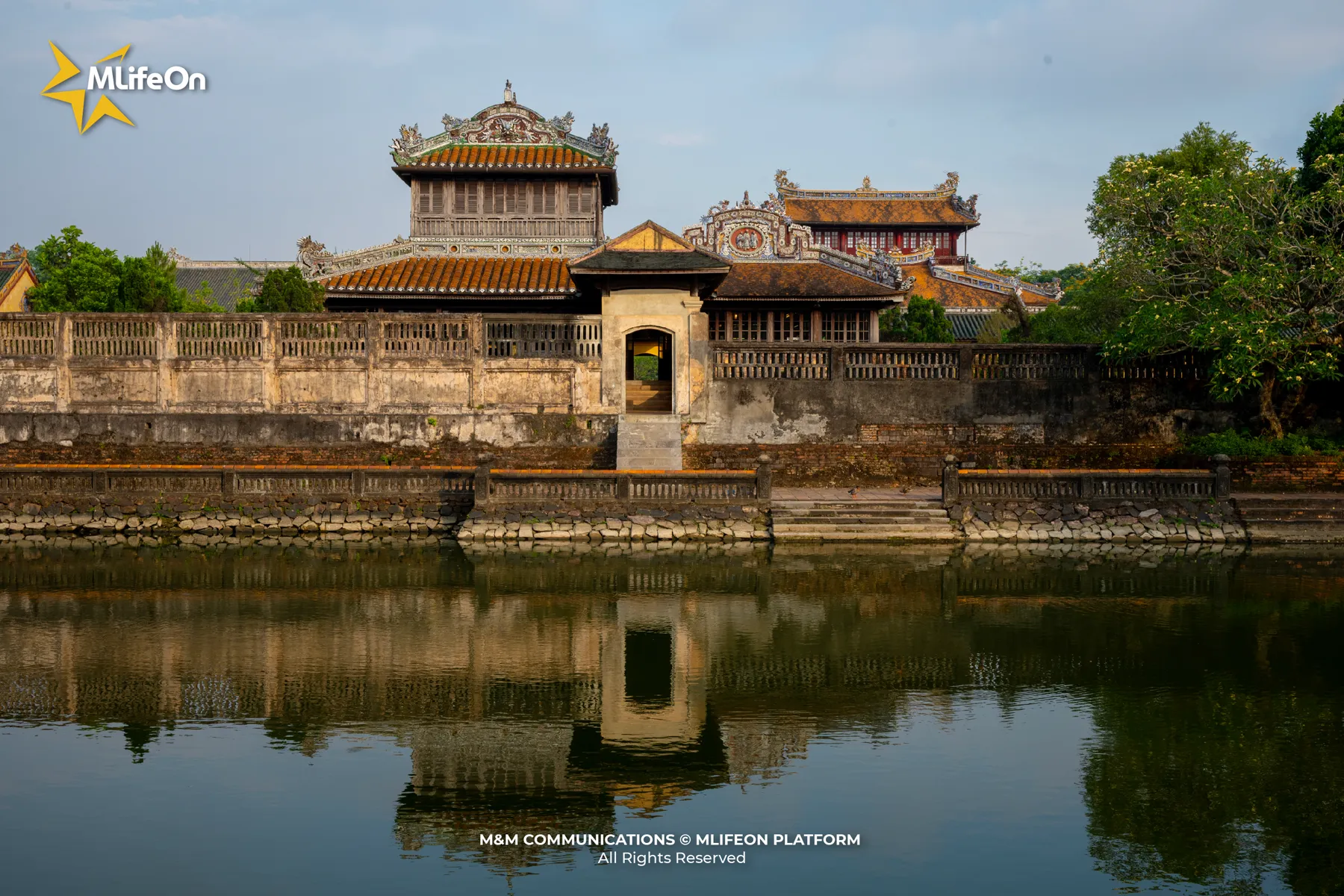
Today's appearance and tomorrow's future
After many years of being affected by war and time, Hue Imperial City has shown signs of deterioration. However, thanks to conservation and restoration projects, many structures have been restored to their original state, bringing a new look to the relic.
Currently, Hue Imperial City is a destination that attracts millions of visitors each year. Experiential activities such as wearing royal costumes, watching royal music performances, night tours, etc. are being implemented to bring the heritage closer to the public.
In the future, perhaps 3D reconstruction and cultural tourism development will be an important direction to preserve and promote the value of Hue Imperial City - not only a relic, but also a vibrant space of Vietnamese culture.
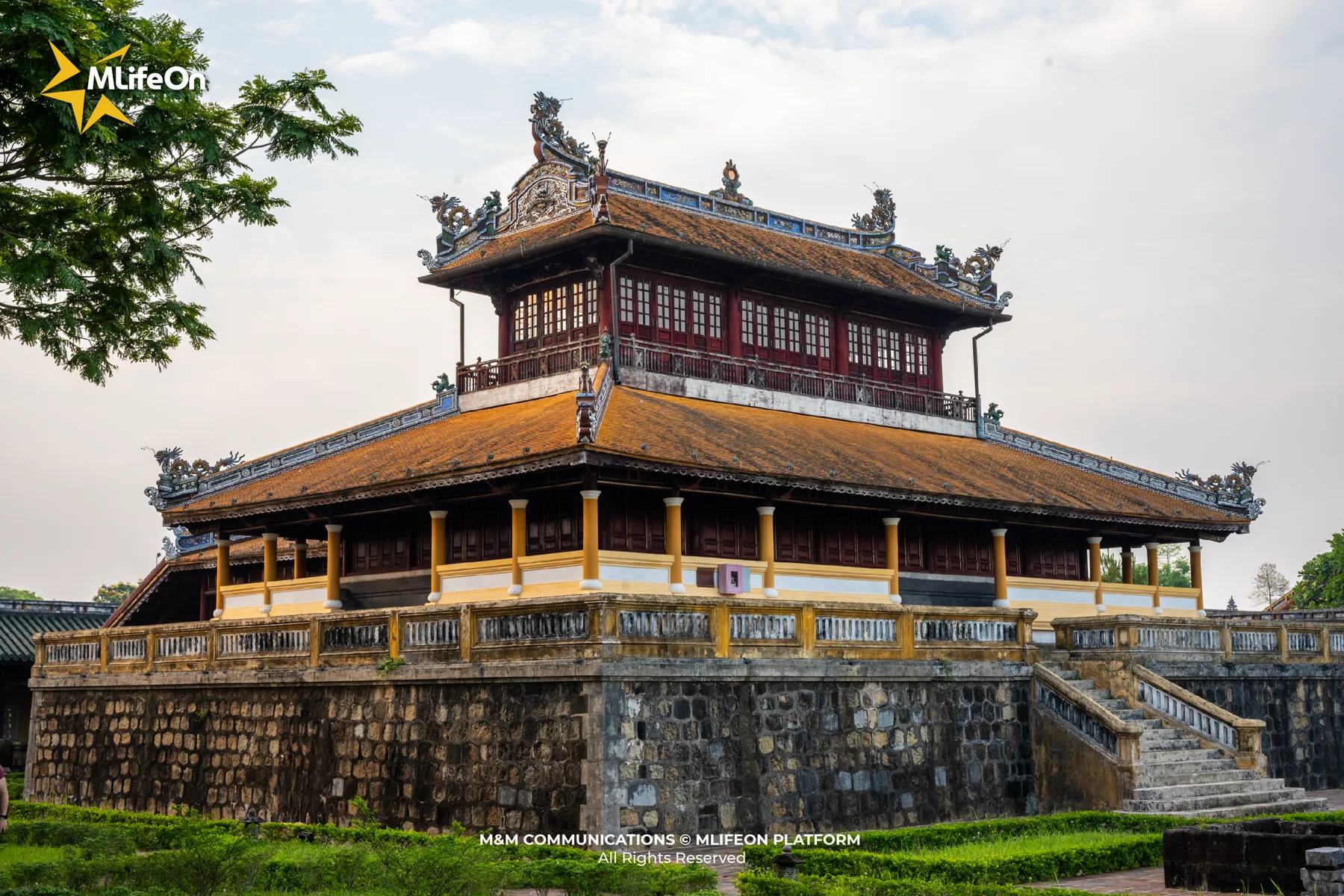
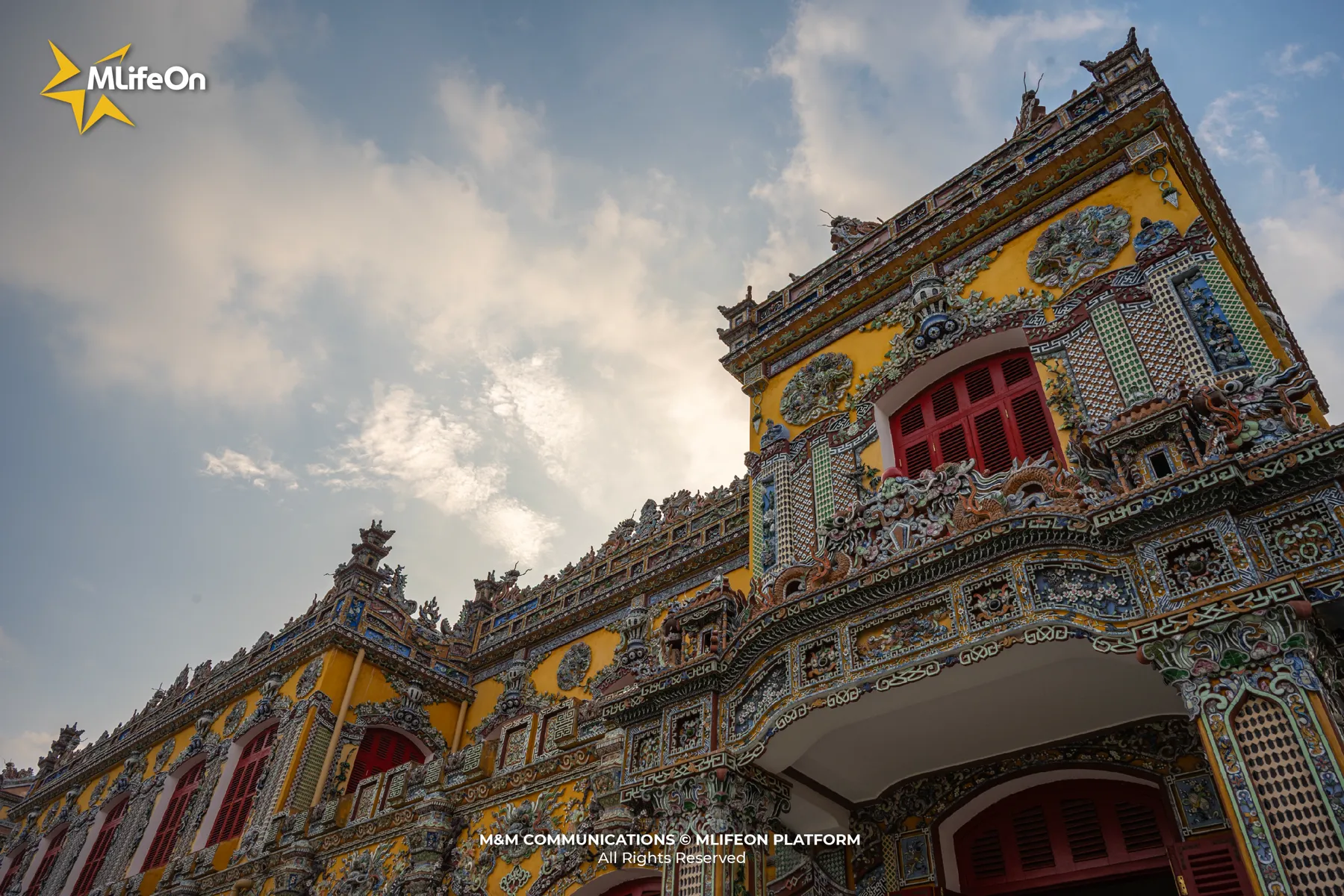
Conclusion
The Imperial City of Hue is not just an architectural complex, but a symphony of history, art and spirituality. Each building, each detail tells a story - about power, about culture, and about the Vietnamese people.
If you ever come to Hue, take the time to walk through Ngo Mon Gate, walk around the Forbidden City, quietly look at Thai Hoa Palace... to discover the beauty of the building considered a symbol of power of the former Nguyen Dynasty.
—-----
CREDIT:
- Photography: Luan Nguyen
- Content: Giang Huynh
- Design: Trung Huynh





















